The document discusses the issue of juvenile delinquency in the United States, emphasizing the rising rates of crime among individuals under 18 and the need for better understanding and intervention strategies. It examines factors contributing to delinquency, such as poverty, peer influence, and environmental conditions, as well as the implementation of policies like zero tolerance that aim to manage youth crime. Additionally, the paper applies routine activity theory and other developmental theories to explore the relationship between environmental factors and juvenile behavior.

![title of the paper, your name,
course name and number,
instructor name, and the
date. See your Ashford-
approved style guide for a
sample title page.) [Marion
Baird]
JUVENILE DELINQUENCY AND THEORY APPLICATION
2
Criminal justice in the United States is facing significant
challenges based on an
increasing rate of criminal offending. Juvenile delinquency is a
significant problem within the
United States, which creates a disproportional system that is
unable to maintain a stronger
understanding of positive behavior. Juvenile delinquency has
been a considerable challenge
within law enforcement. These are young individuals under
18 years who are involved in
offending. Involvement in crime presents a difficult platform](https://image.slidesharecdn.com/runningheadjuveniledelinquencyandtheoryapplication-221025203809-2bd087d0/75/Running-head-JUVENILE-DELINQUENCY-AND-THEORY-APPLICATION-docx-2-2048.jpg)
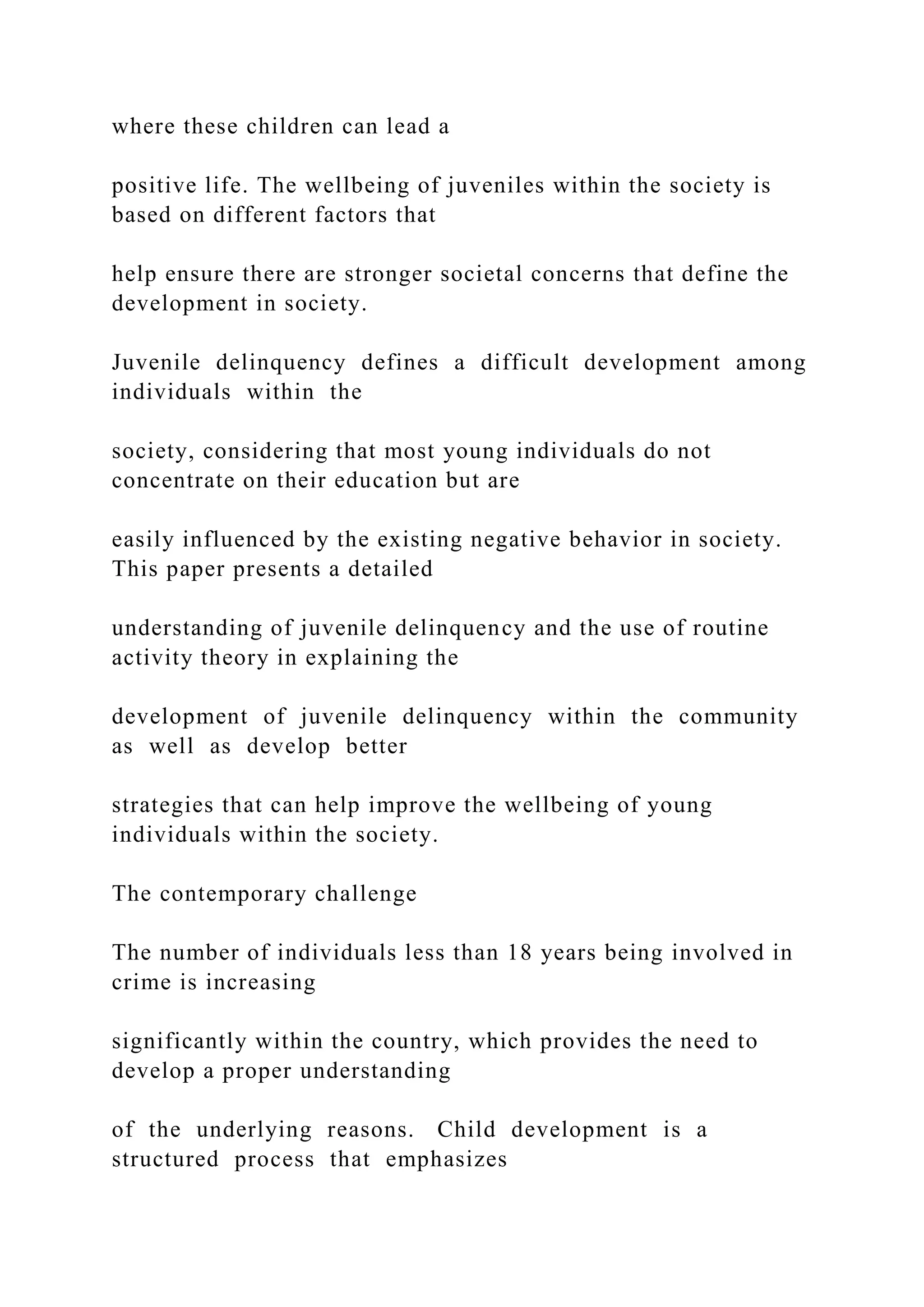
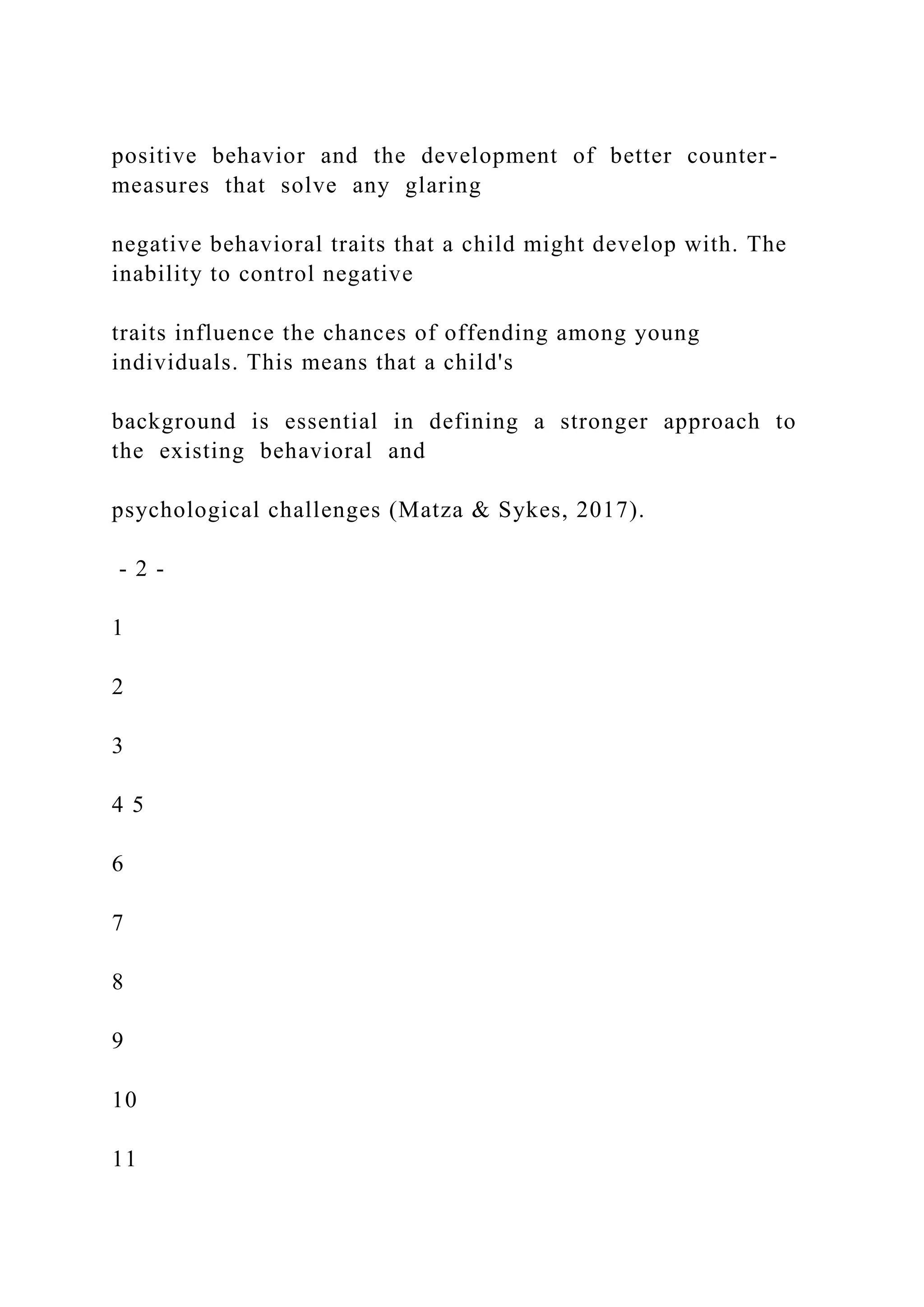
![12 13
1. JUVENILE
Running head is only on the
Title page. [Marion Baird]
2. criminal
Subject-verb agreement:
The subject (noun) of the
sentence should always
agree with its verb (action
word) in number and person.
Example: "The students are
(not 'sis's) excited about
returning to school."
[Marion Baird]
3. behavior.
Where is the supportive
research? [Marion Baird]
4. These](https://image.slidesharecdn.com/runningheadjuveniledelinquencyandtheoryapplication-221025203809-2bd087d0/75/Running-head-JUVENILE-DELINQUENCY-AND-THEORY-APPLICATION-docx-5-2048.jpg)
![Juveniles [Marion Baird]
5. years
of age [Marion Baird]
6. offending.
committing a crime?
[Marion Baird]
7. society.
Where is the research?
[Marion Baird]
8. but
(Use a comma before
coordinating conjunctions -
for, and, nor, but, or, yet, so
- to separate independent
clauses. Example: "Liz
enjoys her writing course, so
she is excited to work hard
at it.") [Marion Baird]](https://image.slidesharecdn.com/runningheadjuveniledelinquencyandtheoryapplication-221025203809-2bd087d0/75/Running-head-JUVENILE-DELINQUENCY-AND-THEORY-APPLICATION-docx-6-2048.jpg)
![9. This paper
The paper does not present
anything. The
author/researcher analyzes,
synthesizes, and
paraphrases research.
[Marion Baird]
10. better
Why is this sentence
justified? [Marion Baird]
11. challenge
(Review APA format
regarding headings.)
[Marion Baird]
12. reasons.
Research support? [Marion
Baird]
13. Child](https://image.slidesharecdn.com/runningheadjuveniledelinquencyandtheoryapplication-221025203809-2bd087d0/75/Running-head-JUVENILE-DELINQUENCY-AND-THEORY-APPLICATION-docx-7-2048.jpg)
![How is this information
connected to the previous
statement? [Marion Baird]
JUVENILE DELINQUENCY AND THEORY APPLICATION
3
The implementation of zero tolerance to crime has been a
significant policy
contributing to increased arrests among juveniles. The
zero-tolerance policy was aimed at
helping understand the need to control crime by ensuring
that there is a higher level of
commitment to positive level development. Juvenile
offending can be considered as
normative adolescent offending, which is influenced to a more
substantial extent by peers and
the environment (Unayah & Sabarisman, 2015). Crime
occurs where there is a favorable
environment where there all parties are engaged. Juveniles are
more likely to be associated
with nonviolent offending, although repeating offenders is
associated with violent crimes.](https://image.slidesharecdn.com/runningheadjuveniledelinquencyandtheoryapplication-221025203809-2bd087d0/75/Running-head-JUVENILE-DELINQUENCY-AND-THEORY-APPLICATION-docx-8-2048.jpg)
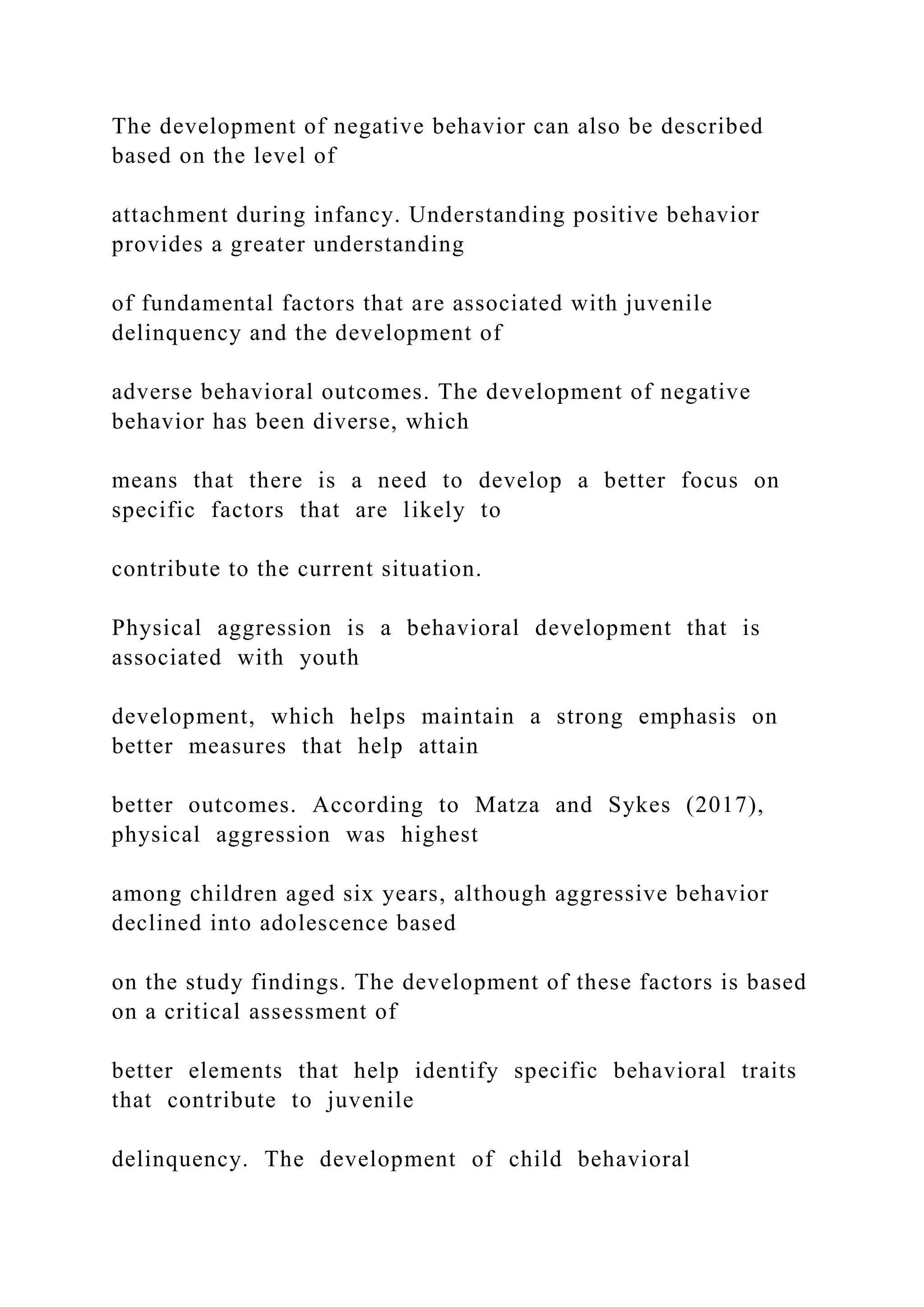
![wellbeing begins during infancy under
which there is a strong attachment. Attachment can be positive
or negative based on how a
child is engaged (Matza & Sykes, 2017).
- 3 -
1
2
3
1. development.
Where is the supportive
research? [Marion Baird]
2. crimes.
(Hasty Generalization:
Beware of jumping to
conclusions. You need
more information before you
can make this assumption.)
[Marion Baird]
3. infancy.](https://image.slidesharecdn.com/runningheadjuveniledelinquencyandtheoryapplication-221025203809-2bd087d0/75/Running-head-JUVENILE-DELINQUENCY-AND-THEORY-APPLICATION-docx-10-2048.jpg)
![(Provide research -
quotations, data, etc. - to
support this assertion.)
[Marion Baird]
JUVENILE DELINQUENCY AND THEORY APPLICATION
4
According to Li et al. (2014), different perspectives provide a
strong understanding of
the minimum age of criminal responsibility. Various aspects,
including clinical, sociological,
developmental, and legal perspectives, which are essential to
consider in maintaining better
outcomes. The age at which a child is perceived to be seen to be
mature enough to stand trial
has always been a challenge. The legitimacy of the minimum
age that has been adopted is
different. It provides a more significant commitment to
fundamental changes that give a
stronger emphasis on critical changes that provide a
strategic development where it is
possible to understand factors that increase the severity of](https://image.slidesharecdn.com/runningheadjuveniledelinquencyandtheoryapplication-221025203809-2bd087d0/75/Running-head-JUVENILE-DELINQUENCY-AND-THEORY-APPLICATION-docx-11-2048.jpg)
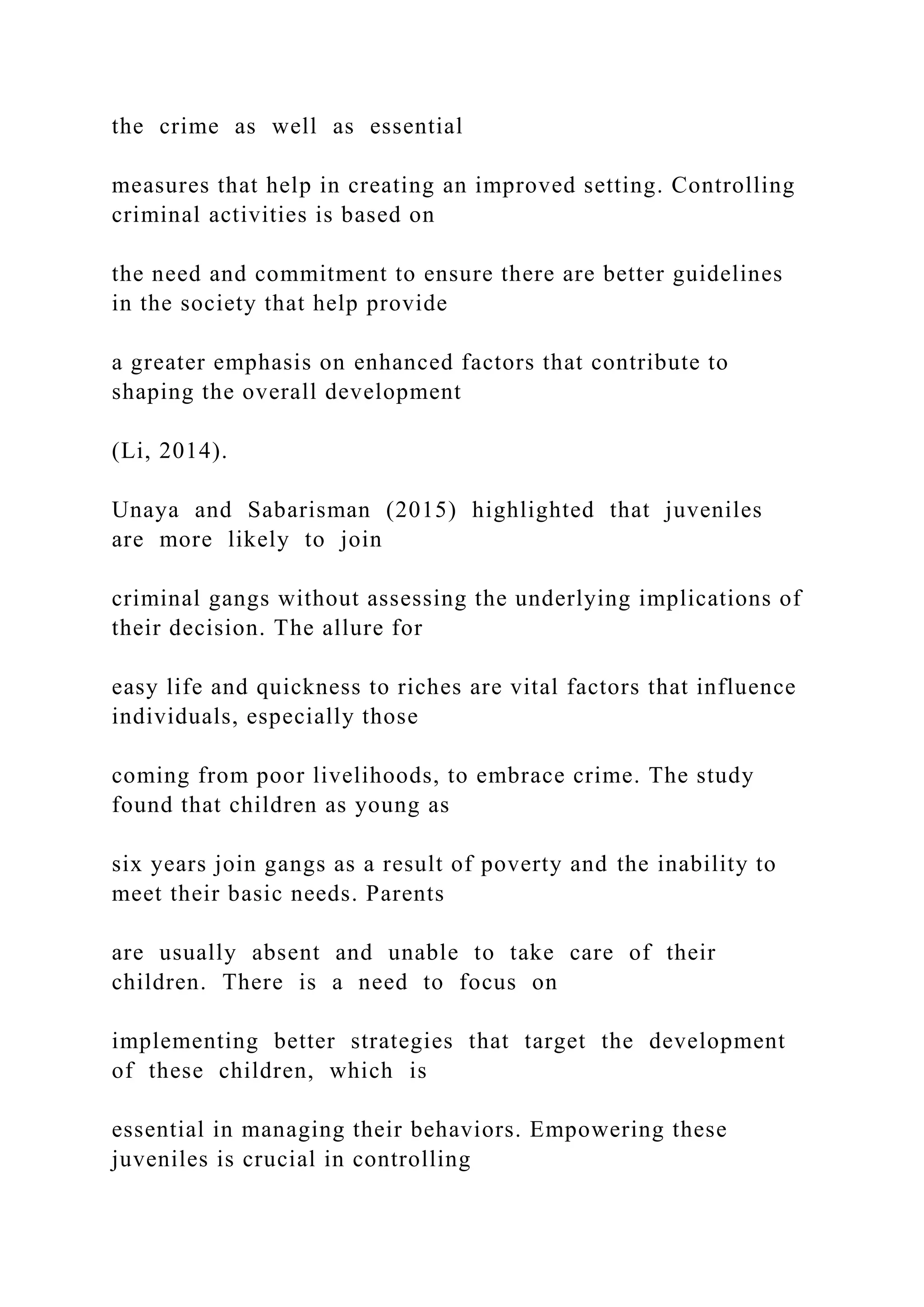
![delinquency. The majority of gang members in the United States
are minority groups who
mainly occupy the low-income population. The low quality
of life presents a stressful
environment where it is difficult to assess and determine critical
processes that help define a
strong understanding of essential processes that help attain
improved outcomes (Unayah &
Sabarisman, 2015).
- 4 -
1
2
3
1. outcomes.
missing information -
incomplete sentence
[Marion Baird]
2. that
omit [Marion Baird]
3. easy life](https://image.slidesharecdn.com/runningheadjuveniledelinquencyandtheoryapplication-221025203809-2bd087d0/75/Running-head-JUVENILE-DELINQUENCY-AND-THEORY-APPLICATION-docx-13-2048.jpg)
![Is being part of a gang and
easy life? [Marion Baird]
JUVENILE DELINQUENCY AND THEORY APPLICATION
5
Sharkey et al. (2015) sought to develop an emphasis on drug use
and violent crimes
among adolescents. The results of the study showed that alcohol
use was highly associated
with both violent and non-violent crimes. Criminal history
and racial identity were also
identified as critical factors that are associated with
increased violent crimes among
adolescents. Therefore there is a need to understand the crucial
role in controlling essential
elements that help create a reliable platform in managing
these factors, which contribute
identify better processes that define a strong change approach
(Sharkey, Stifel, & Mayworm,
2015).
Living environment and poverty within the community have
been significant factors](https://image.slidesharecdn.com/runningheadjuveniledelinquencyandtheoryapplication-221025203809-2bd087d0/75/Running-head-JUVENILE-DELINQUENCY-AND-THEORY-APPLICATION-docx-14-2048.jpg)

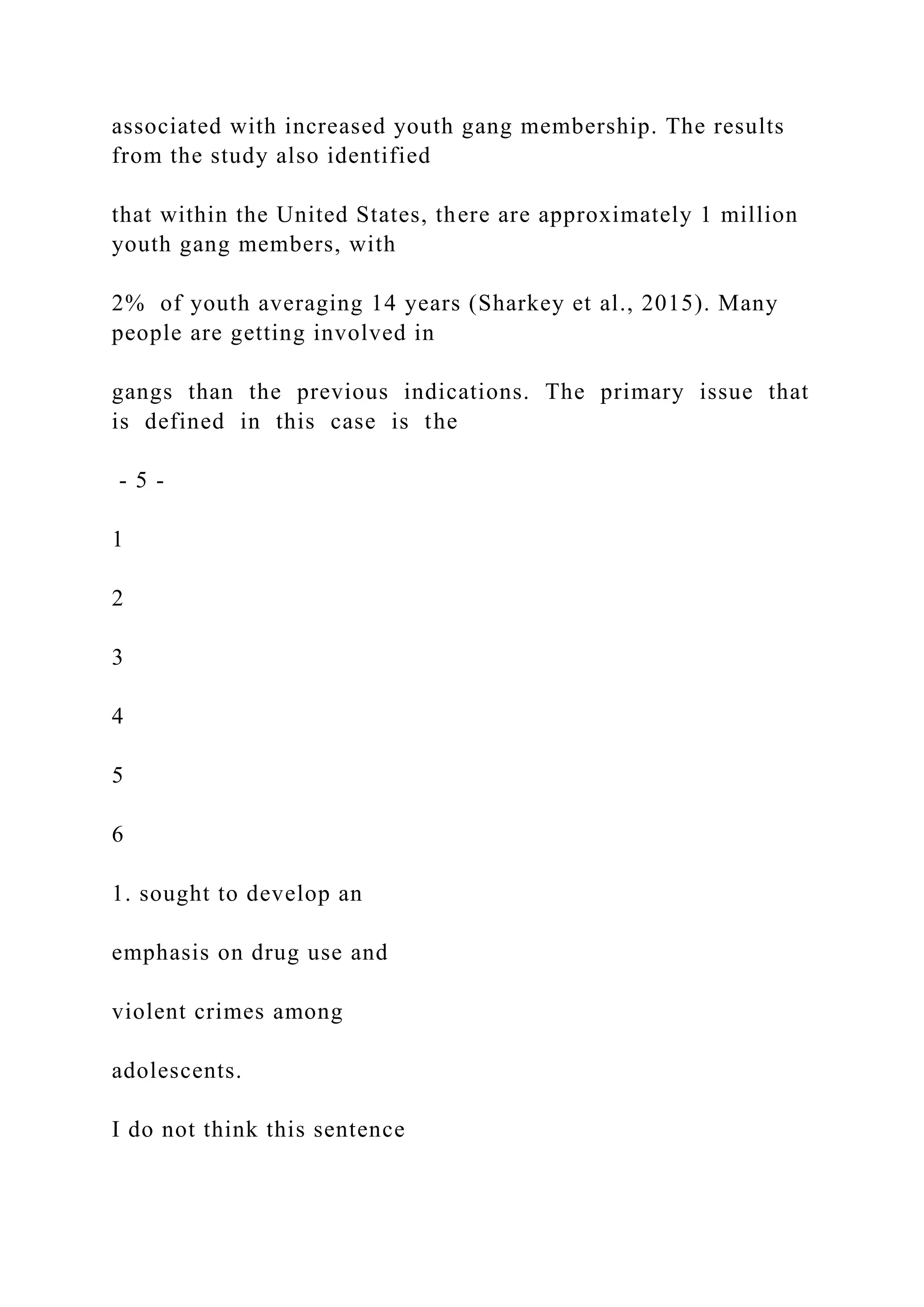
![conveys your meaning.
[Marion Baird]
2. united states.
Proper nouns should be
capitalized. [Marion Baird]
3. poor background
Subject-verb agreement:
The subject (noun) of the
sentence should always
agree with its verb (action
word) in number and person.
Example: "The students are
(not 'sis's) excited about
returning to school."
[Marion Baird]
4. criminal justice.
Criminal justice or crime?
[Marion Baird]](https://image.slidesharecdn.com/runningheadjuveniledelinquencyandtheoryapplication-221025203809-2bd087d0/75/Running-head-JUVENILE-DELINQUENCY-AND-THEORY-APPLICATION-docx-17-2048.jpg)
![5. members.
Where is the research
support? [Marion Baird]
6. indications.
source of information?
[Marion Baird]
JUVENILE DELINQUENCY AND THEORY APPLICATION
6
limited emphasis on controlling gang development. High
poverty levels and lack of formal
education have even identified as primary factors that are
associated with gang development.
Gang involvement has become an option for these
individuals. Many youths are
joining gangs without understanding the psychological
challenges that are associated with
such a move. However, the difficult nature of their
surrounding present a more specific
emphasis on better processes that help define reliable change
processes which improve the
overall commitment to improved outcomes. Thus the](https://image.slidesharecdn.com/runningheadjuveniledelinquencyandtheoryapplication-221025203809-2bd087d0/75/Running-head-JUVENILE-DELINQUENCY-AND-THEORY-APPLICATION-docx-18-2048.jpg)
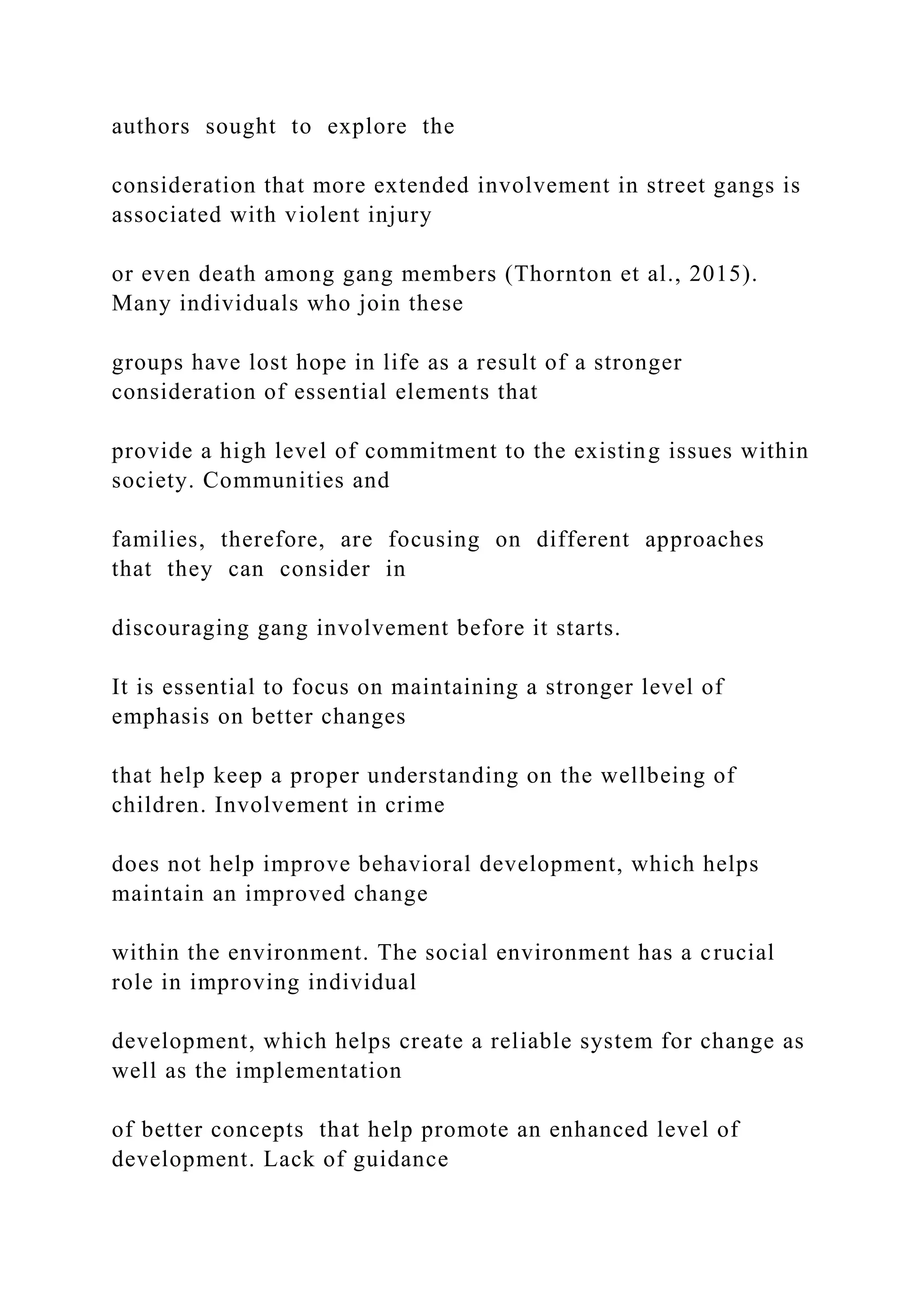
![among children leaves gaps that are exploited by negative
thoughts influencing an individual
behavior (Whitehead & Lab, 2013). Therefore, it is vital
to help understand different
measures that can be integrated within society and understand
essential measures that can be
implemented to help attain the needed outcomes.
Theories
- 6 -
1
1. Theories
(Review APA format
regarding headings.)
[Marion Baird]
JUVENILE DELINQUENCY AND THEORY APPLICATION
7
Different theories have focused on explaining the
involvement in a crime. These
theories mainly focus on behavior and social environment,
which makes it easier for](https://image.slidesharecdn.com/runningheadjuveniledelinquencyandtheoryapplication-221025203809-2bd087d0/75/Running-head-JUVENILE-DELINQUENCY-AND-THEORY-APPLICATION-docx-20-2048.jpg)

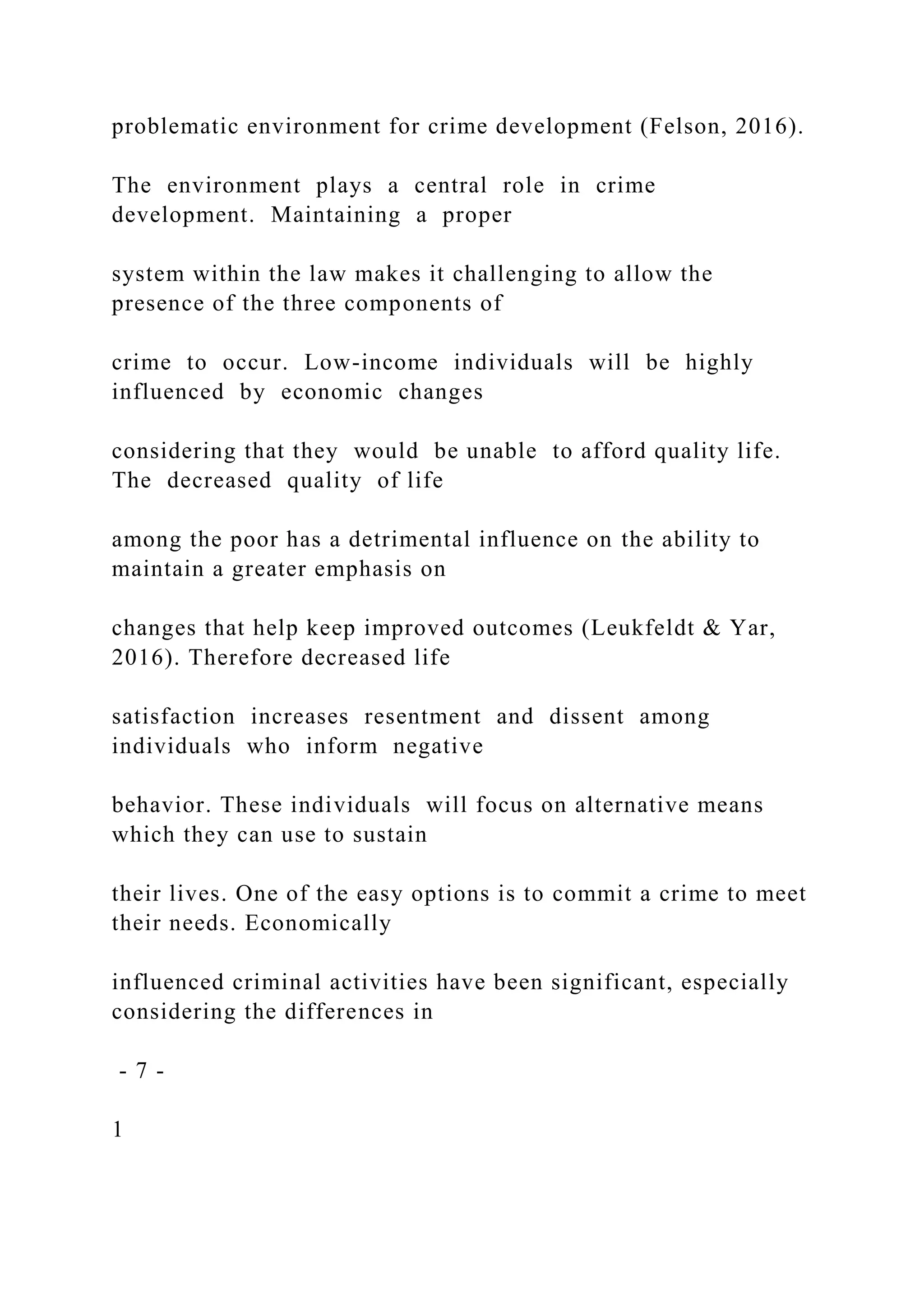
![2
3
4
5
1. environment.
(Please spend some time
thinking about how the
information connects and
work on explaining it in your
writing.) [Marion Baird]
2. no
There is not a ... [Marion
Baird]
3. Therefore
comma needed [Marion
Baird]
4. development.
research? [Marion Baird]](https://image.slidesharecdn.com/runningheadjuveniledelinquencyandtheoryapplication-221025203809-2bd087d0/75/Running-head-JUVENILE-DELINQUENCY-AND-THEORY-APPLICATION-docx-23-2048.jpg)
![5. that
omit [Marion Baird]
JUVENILE DELINQUENCY AND THEORY APPLICATION
8
social status within the community. Low-class individuals are
faced with different problems,
which makes it challenging to avoid crime to meet their needs.
The goal attainment theory also highlights that individual
behavioral development is
based on the level of interaction within the environment.
Thus, child development is a
specific process that helps understand different decisions
within an organizational context.
Implementing a substantial change approach help in
creating a highly successful level of
development where it would be possible to define
behavioral development (House &
Mitchell, 2019). The level of policing across different settings
differs, which helps maintain a
stronger focus on essential processes that help maintain a
successful level of change. Law
enforcement officers are not around all the time, which creates a](https://image.slidesharecdn.com/runningheadjuveniledelinquencyandtheoryapplication-221025203809-2bd087d0/75/Running-head-JUVENILE-DELINQUENCY-AND-THEORY-APPLICATION-docx-24-2048.jpg)
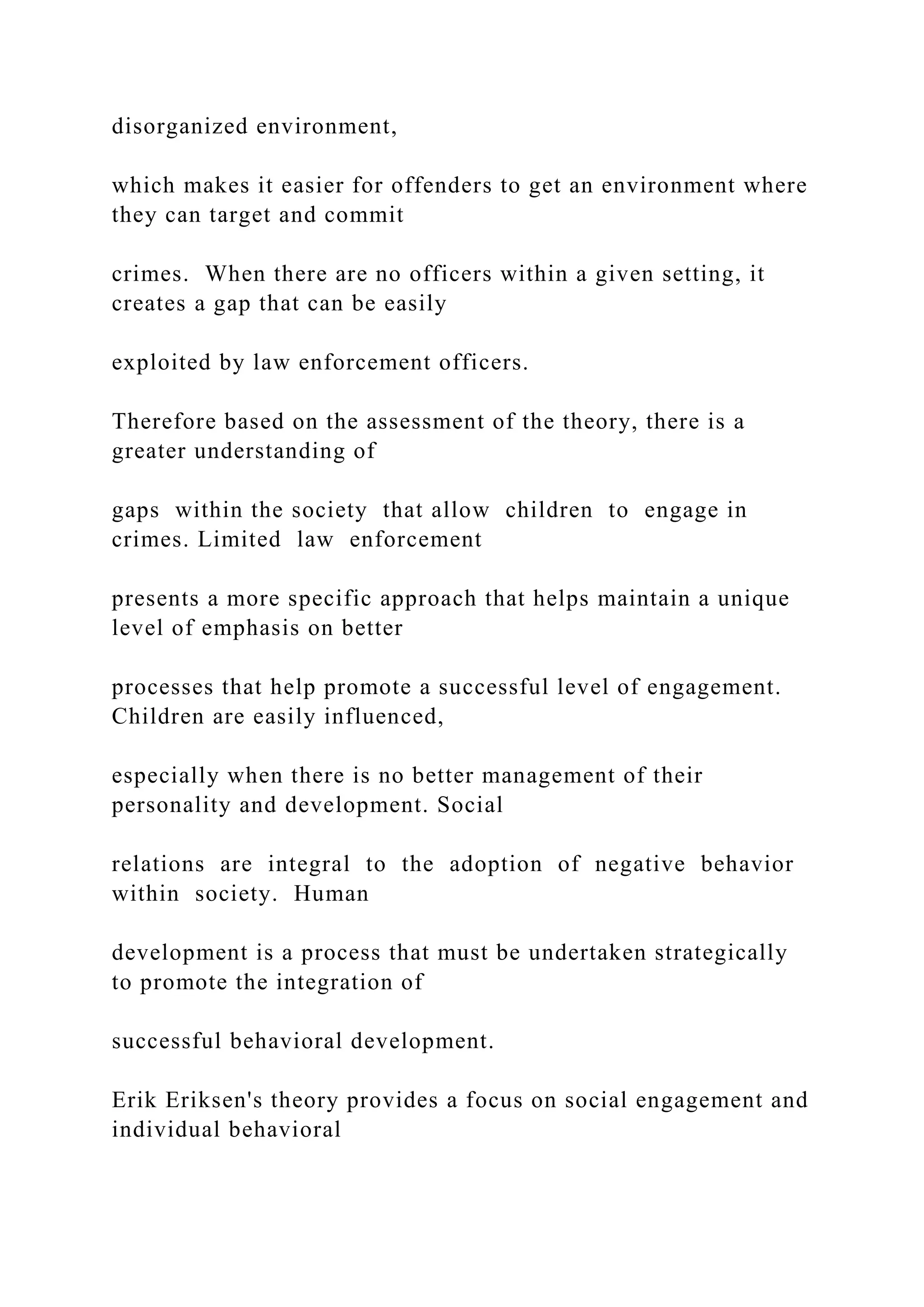
![development. Human development occurs through different
stages, which help identify
essential elements that define strong change development.
Children have different levels of
- 8 -
1
2
3
4
1. needs.
(Hasty Generalization:
Beware of jumping to
conclusions. You need
more information before you
can make this assumption.)
[Marion Baird]
2. context.
How? [Marion Baird]
3. Therefore](https://image.slidesharecdn.com/runningheadjuveniledelinquencyandtheoryapplication-221025203809-2bd087d0/75/Running-head-JUVENILE-DELINQUENCY-AND-THEORY-APPLICATION-docx-26-2048.jpg)
![comma needed [Marion
Baird]
4. Eriksen's theory
source? [Marion Baird]
JUVENILE DELINQUENCY AND THEORY APPLICATION
9
understanding, which plays a significant role in transforming
their behavior. It is crucial to
help ensure a greater emphasis on critical processes that help
identify better measures that
shape individual development. Children have different levels of
understanding, which plays a
crucial role in determining their overall growth (Mann, De
Ridder, and Fujita, 2013).
Application of the theories
Offenders are individuals who are influenced by negative
behavior and intention to
pursue the crime. Victims are always present within the
society, which makes it essential to
consider the third component of a crime, which is to
eliminate lawlessness. Disorganized](https://image.slidesharecdn.com/runningheadjuveniledelinquencyandtheoryapplication-221025203809-2bd087d0/75/Running-head-JUVENILE-DELINQUENCY-AND-THEORY-APPLICATION-docx-27-2048.jpg)
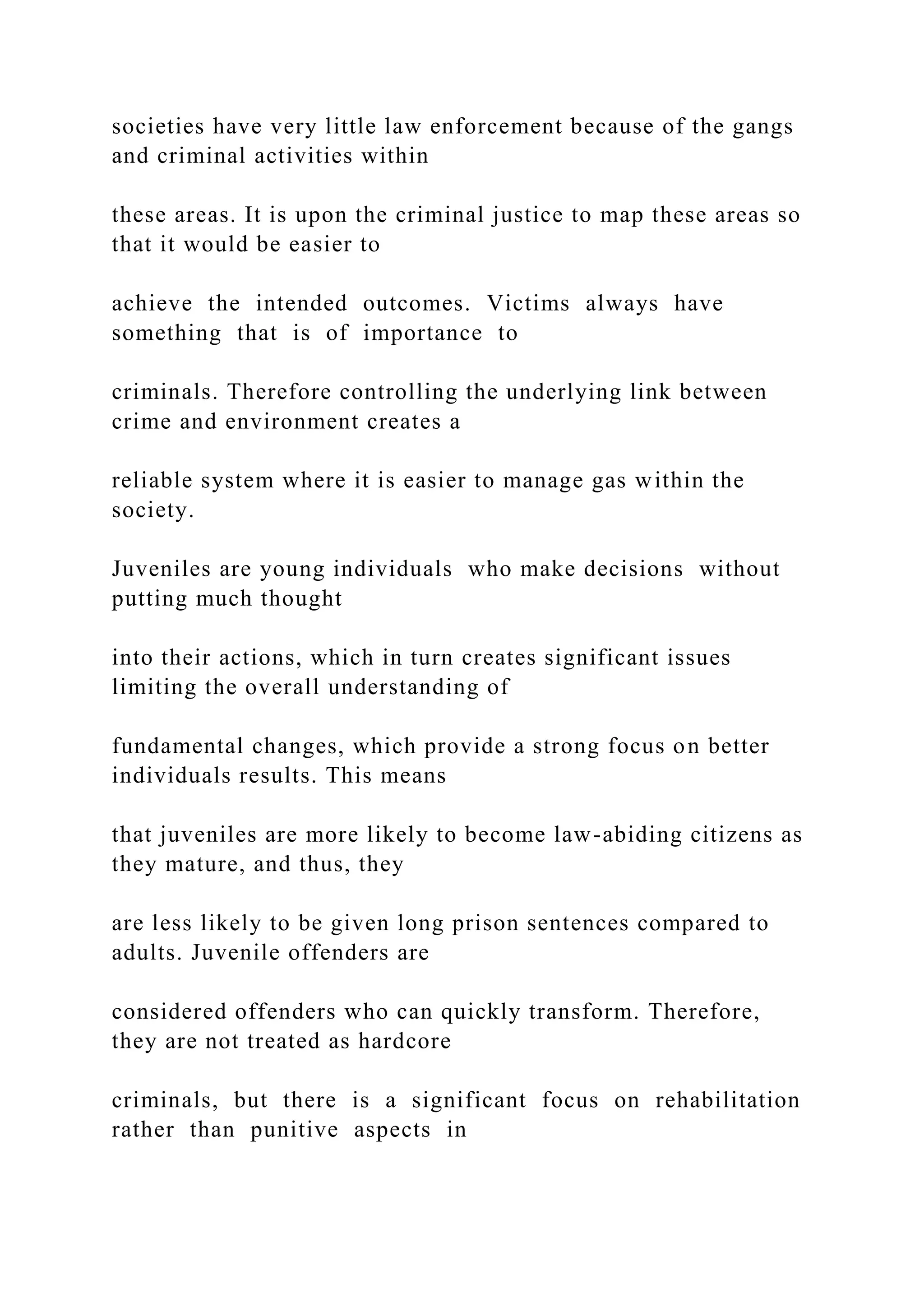
![managing their needs. However, there are substantial risks for
juvenile offenders if they are
tried as adults (Whitehead & Lab, 2013).
Controlling crime among juveniles requires a stranger approach,
which helps maintain
a stronger system, which is essential in embracing strong
change development. Maintaining a
- 9 -
1
1. theories
(Review APA format
regarding headings.)
[Marion Baird]
JUVENILE DELINQUENCY AND THEORY APPLICATION
10
substantial platform help in creating a secure change process
considering the need to maintain
a highly effective system and change development. Improving
the behavior of children forms
the basis of attaining highly effective methods within an
organizational context. Children who](https://image.slidesharecdn.com/runningheadjuveniledelinquencyandtheoryapplication-221025203809-2bd087d0/75/Running-head-JUVENILE-DELINQUENCY-AND-THEORY-APPLICATION-docx-29-2048.jpg)
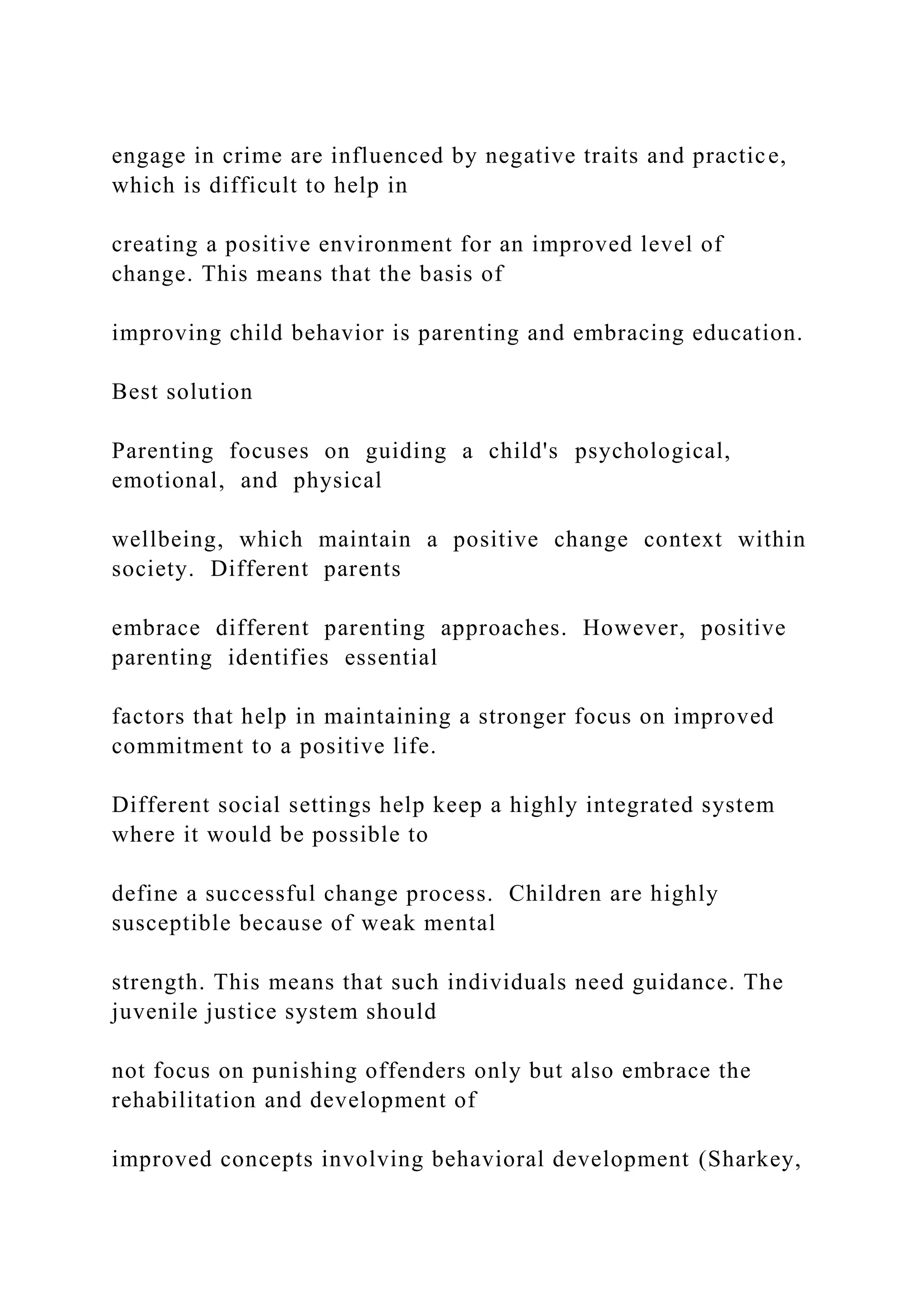
![Stifel, and Mayworm, 2015).
The relationship between a child and his or her parents is
invaluable, which is
adequately explained based on infant attachment. Infant
attachment presents a firm
understanding of child development, which offers a
transparent approach in helping
understand different elements that need to be assessed in
determining better outcomes.
Relationships that are formed during infancy are crucial in
defining a stronger influence on
child behavioral and cognitive development. Relationships at a
younger age are essential in
transforming a child's mental wellbeing. Child development is
necessary at the infant stage,
where they learn and store. Learning is a continuous
process, although during childhood,
- 10 -
1
1. wellbeing.
Where is the research?
[Marion Baird]](https://image.slidesharecdn.com/runningheadjuveniledelinquencyandtheoryapplication-221025203809-2bd087d0/75/Running-head-JUVENILE-DELINQUENCY-AND-THEORY-APPLICATION-docx-31-2048.jpg)
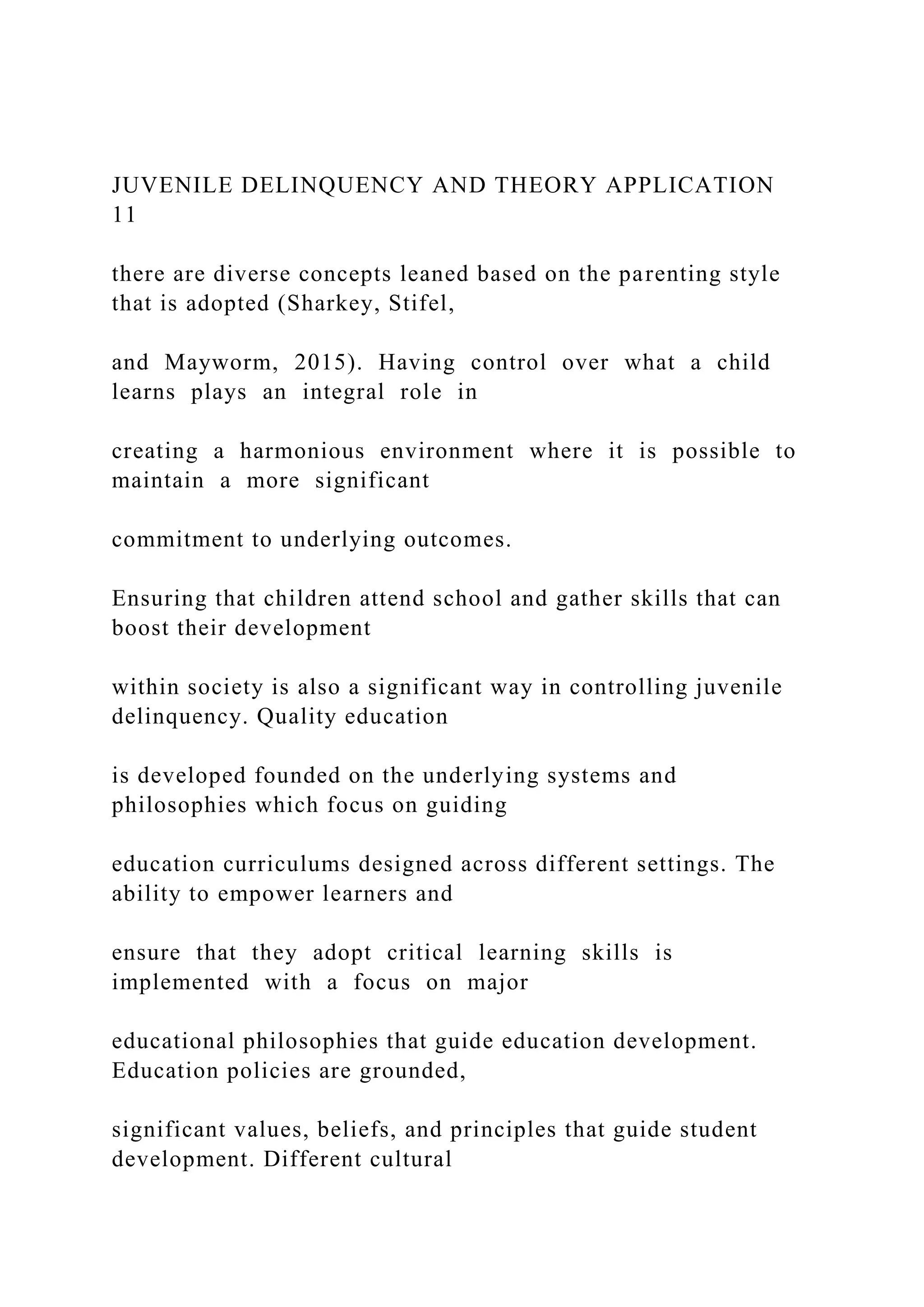
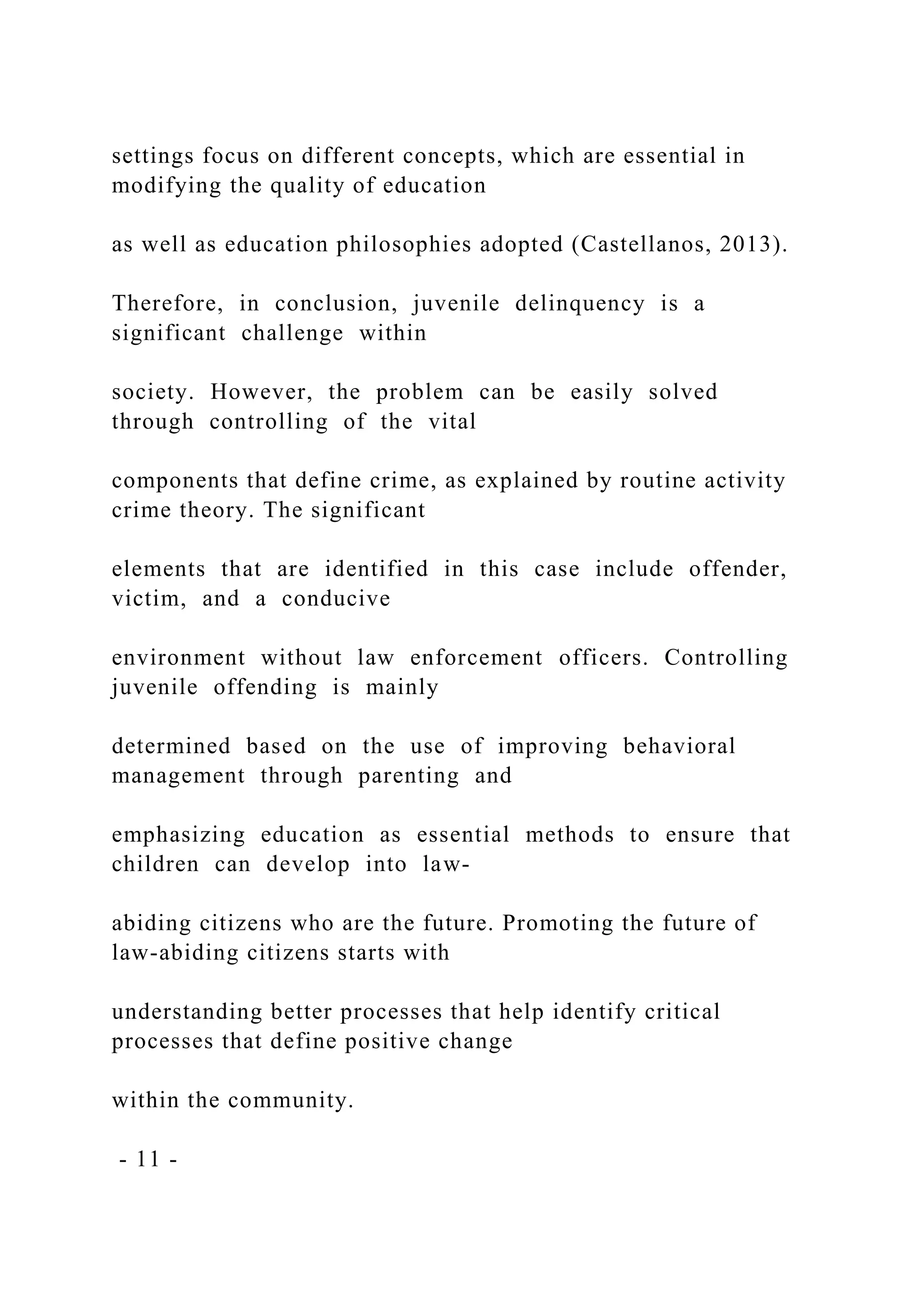
![[no notes on this page]
JUVENILE DELINQUENCY AND THEORY APPLICATION
12
Reference
Andresen, M. A., & Ha, O. K. (2019). Routine activity theory.
In The Routledge Companion
to Criminological Theory and Concepts.
https://doi.org/10.4324/9781315744902-121
Castellanos, I. E. (2013). Parental and peer influence on
juvenile delinquency. ProQuest
Dissertations and Theses.
Felson, M. (2016). The routine activity approach. In
Environmental Criminology and Crime
Analysis: Second Edition.
https://doi.org/10.4324/9781315709826
Gase, L. N., DeFosset, A., Kuo, T., & Perry, R. (2016). Youths’
perspectives on the reasons
underlying school truancy and opportunities to improve school
attendance. Qualitative
Report.
House, R. J., & Mitchell, T. R. (2019). Path-Goal Theory of](https://image.slidesharecdn.com/runningheadjuveniledelinquencyandtheoryapplication-221025203809-2bd087d0/75/Running-head-JUVENILE-DELINQUENCY-AND-THEORY-APPLICATION-docx-34-2048.jpg)
![Leadership. In Leadership.
https://doi.org/10.2307/j.ctvpg85tk.25
Leukfeldt, E. R., & Yar, M. (2016). Applying Routine Activity
Theory to Cybercrime: A
Theoretical and Empirical Analysis. Deviant Behavior.
https://doi.org/10.1080/01639625.2015.1012409
Li, S. D. (2014). Familial Religiosity, Family Processes, and
Juvenile Delinquency in a
National Sample of Early Adolescents. Journal of Early
Adolescence.
https://doi.org/10.1177/0272431613495445
- 12 -
1
1. Reference
References page must
follow APA guidelines.
[Marion Baird]
JUVENILE DELINQUENCY AND THEORY APPLICATION
13](https://image.slidesharecdn.com/runningheadjuveniledelinquencyandtheoryapplication-221025203809-2bd087d0/75/Running-head-JUVENILE-DELINQUENCY-AND-THEORY-APPLICATION-docx-35-2048.jpg)
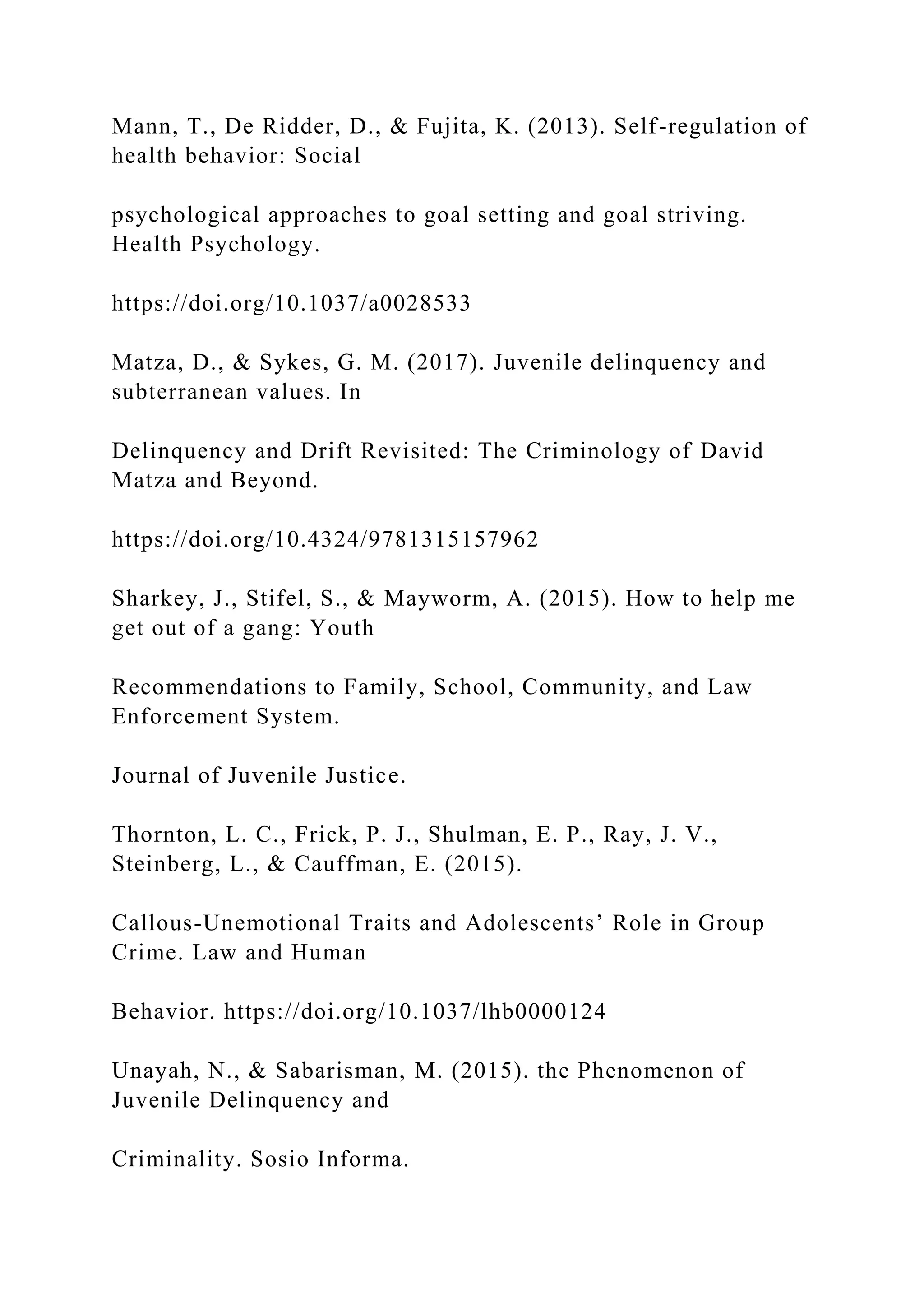
![https://doi.org/http://dx.doi.org/10.22146/jpsi.6959
Whitehead, J. T., & Lab, S. P. (2013). Chapter 14 – Future
Directions in Juvenile Justice. In
Juvenile Justice. https://doi.org/10.1016/B978-1-4557-7892-
8.00014-7
- 13 -
[no notes on this page]
Running head: JUVENILE DELINQUENCY AND THEORY
APPLICATION 1
Juvenile Delinquency and Theory Application
Matthew Manuel Rosario
Ashford University
- 1 -
1
1. APPLICATION
Shorten the title for the
Running head.
(Your title page should](https://image.slidesharecdn.com/runningheadjuveniledelinquencyandtheoryapplication-221025203809-2bd087d0/75/Running-head-JUVENILE-DELINQUENCY-AND-THEORY-APPLICATION-docx-37-2048.jpg)
![contain a shortened version
of your title with "Running
head" in the upper left
corner and page number 1 in
the upper right corner. In the
center of the page add the
title of the paper, your name,
course name and number,
instructor name, and the
date. See your Ashford-
approved style guide for a
sample title page.) [Marion
Baird]
JUVENILE DELINQUENCY AND THEORY APPLICATION
2
Criminal justice in the United States is facing significant
challenges based on an
increasing rate of criminal offending. Juvenile delinquency is a
significant problem within the](https://image.slidesharecdn.com/runningheadjuveniledelinquencyandtheoryapplication-221025203809-2bd087d0/75/Running-head-JUVENILE-DELINQUENCY-AND-THEORY-APPLICATION-docx-38-2048.jpg)
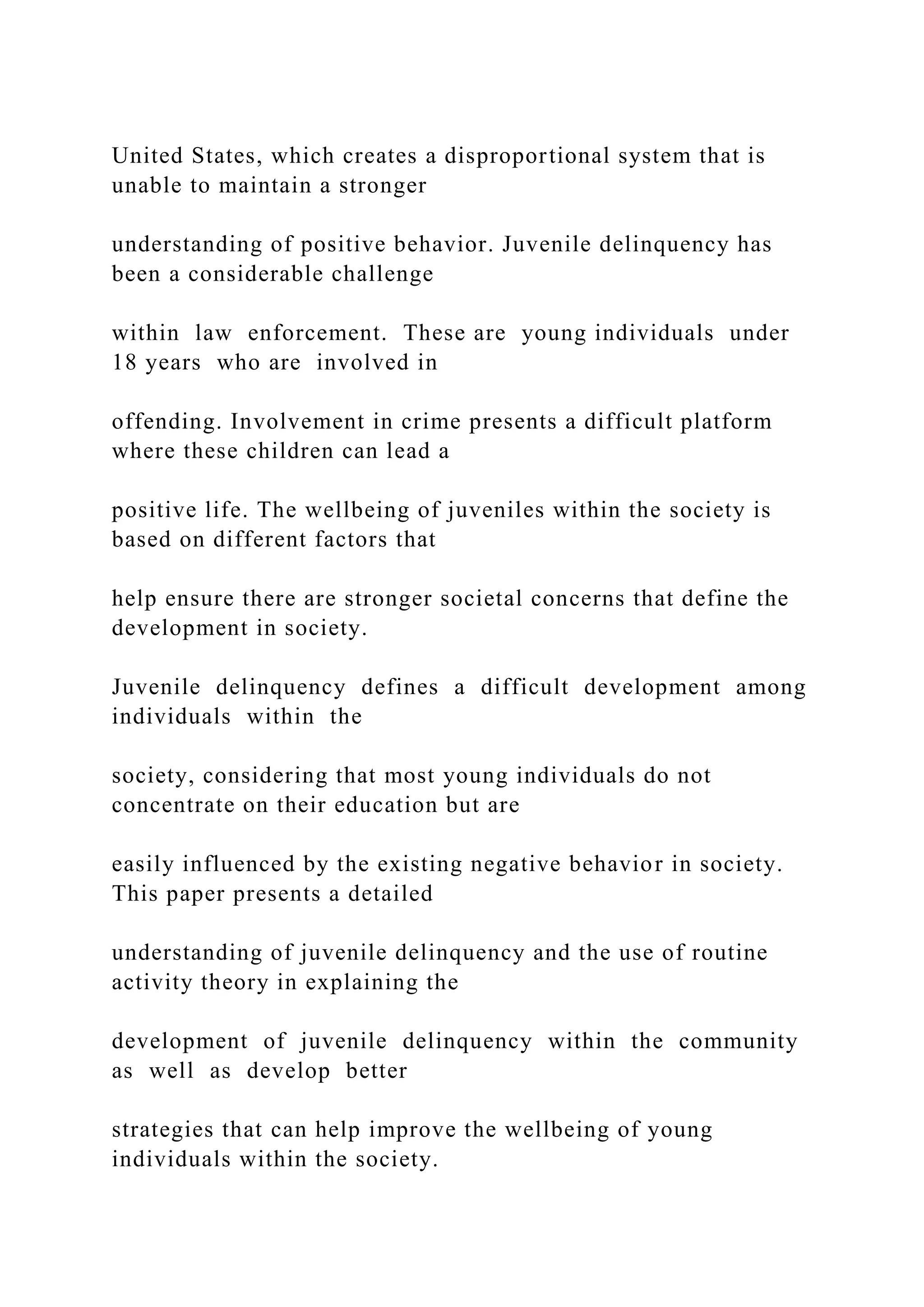
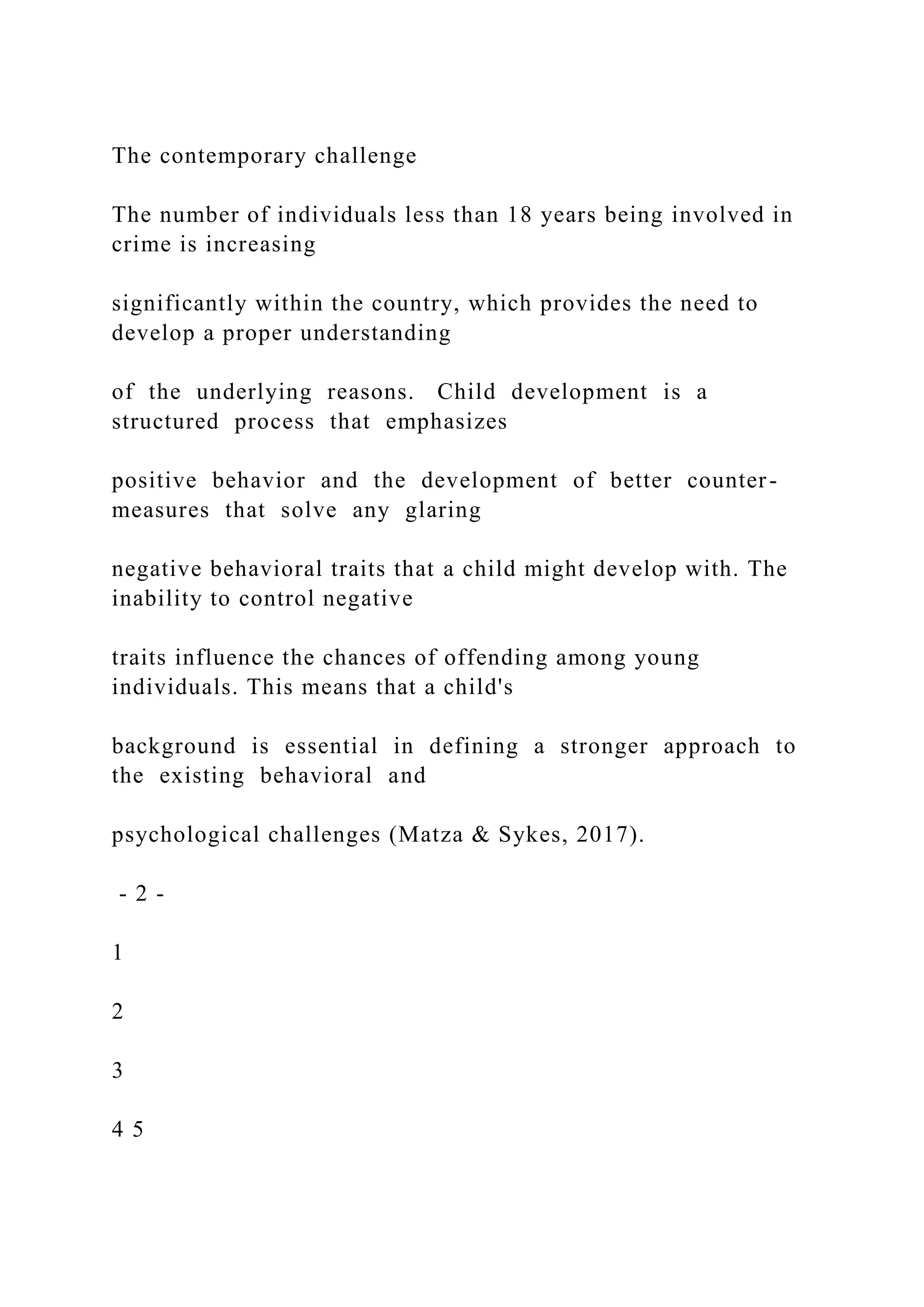
![6
7
8
9
10
11
12 13
1. JUVENILE
Running head is only on the
Title page. [Marion Baird]
2. criminal
Subject-verb agreement:
The subject (noun) of the
sentence should always
agree with its verb (action
word) in number and person.
Example: "The students are
(not 'sis's) excited about](https://image.slidesharecdn.com/runningheadjuveniledelinquencyandtheoryapplication-221025203809-2bd087d0/75/Running-head-JUVENILE-DELINQUENCY-AND-THEORY-APPLICATION-docx-41-2048.jpg)
![returning to school."
[Marion Baird]
3. behavior.
Where is the supportive
research? [Marion Baird]
4. These
Juveniles [Marion Baird]
5. years
of age [Marion Baird]
6. offending.
committing a crime?
[Marion Baird]
7. society.
Where is the research?
[Marion Baird]
8. but
(Use a comma before
coordinating conjunctions -](https://image.slidesharecdn.com/runningheadjuveniledelinquencyandtheoryapplication-221025203809-2bd087d0/75/Running-head-JUVENILE-DELINQUENCY-AND-THEORY-APPLICATION-docx-42-2048.jpg)
![for, and, nor, but, or, yet, so
- to separate independent
clauses. Example: "Liz
enjoys her writing course, so
she is excited to work hard
at it.") [Marion Baird]
9. This paper
The paper does not present
anything. The
author/researcher analyzes,
synthesizes, and
paraphrases research.
[Marion Baird]
10. better
Why is this sentence
justified? [Marion Baird]
11. challenge
(Review APA format](https://image.slidesharecdn.com/runningheadjuveniledelinquencyandtheoryapplication-221025203809-2bd087d0/75/Running-head-JUVENILE-DELINQUENCY-AND-THEORY-APPLICATION-docx-43-2048.jpg)
![regarding headings.)
[Marion Baird]
12. reasons.
Research support? [Marion
Baird]
13. Child
How is this information
connected to the previous
statement? [Marion Baird]
JUVENILE DELINQUENCY AND THEORY APPLICATION
3
The implementation of zero tolerance to crime has been a
significant policy
contributing to increased arrests among juveniles. The
zero-tolerance policy was aimed at
helping understand the need to control crime by ensuring
that there is a higher level of
commitment to positive level development. Juvenile
offending can be considered as
normative adolescent offending, which is influenced to a more](https://image.slidesharecdn.com/runningheadjuveniledelinquencyandtheoryapplication-221025203809-2bd087d0/75/Running-head-JUVENILE-DELINQUENCY-AND-THEORY-APPLICATION-docx-44-2048.jpg)
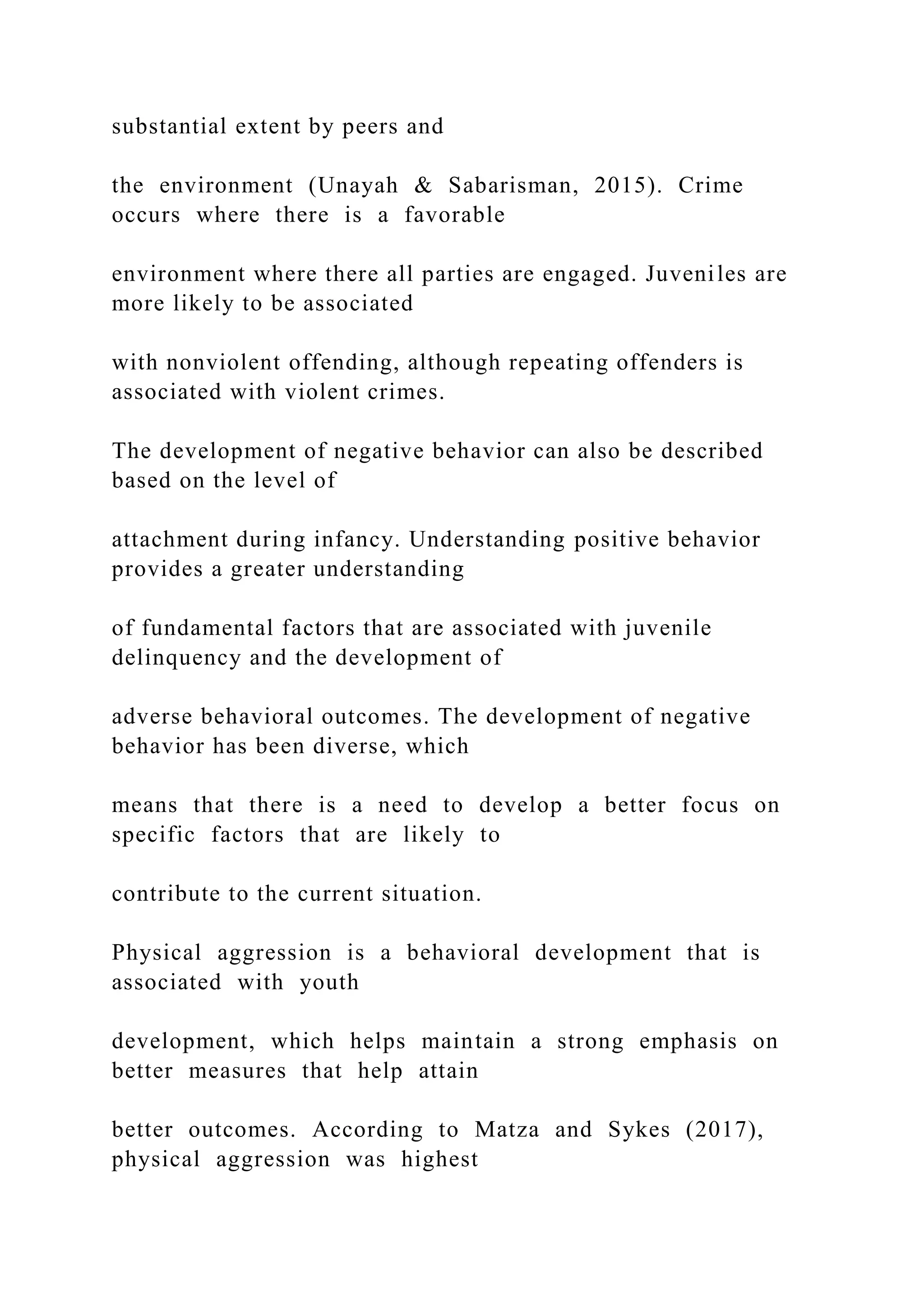
![among children aged six years, although aggressive behavior
declined into adolescence based
on the study findings. The development of these factors is based
on a critical assessment of
better elements that help identify specific behavioral traits
that contribute to juvenile
delinquency. The development of child behavioral
wellbeing begins during infancy under
which there is a strong attachment. Attachment can be positive
or negative based on how a
child is engaged (Matza & Sykes, 2017).
- 3 -
1
2
3
1. development.
Where is the supportive
research? [Marion Baird]
2. crimes.
(Hasty Generalization:](https://image.slidesharecdn.com/runningheadjuveniledelinquencyandtheoryapplication-221025203809-2bd087d0/75/Running-head-JUVENILE-DELINQUENCY-AND-THEORY-APPLICATION-docx-46-2048.jpg)
![Beware of jumping to
conclusions. You need
more information before you
can make this assumption.)
[Marion Baird]
3. infancy.
(Provide research -
quotations, data, etc. - to
support this assertion.)
[Marion Baird]
JUVENILE DELINQUENCY AND THEORY APPLICATION
4
According to Li et al. (2014), different perspectives provide a
strong understanding of
the minimum age of criminal responsibility. Various aspects,
including clinical, sociological,
developmental, and legal perspectives, which are essential to
consider in maintaining better
outcomes. The age at which a child is perceived to be seen to be
mature enough to stand trial](https://image.slidesharecdn.com/runningheadjuveniledelinquencyandtheoryapplication-221025203809-2bd087d0/75/Running-head-JUVENILE-DELINQUENCY-AND-THEORY-APPLICATION-docx-47-2048.jpg)

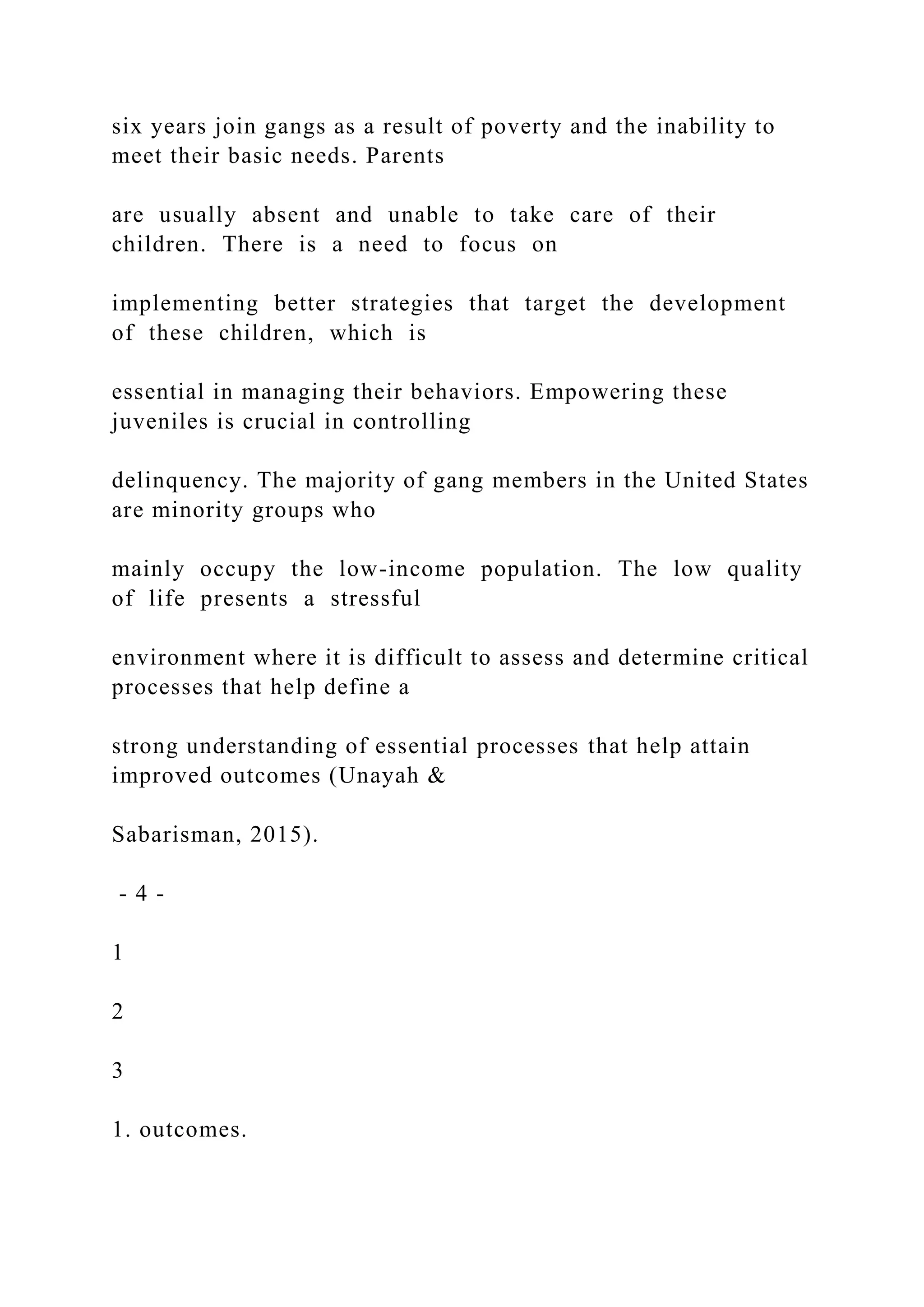
![missing information -
incomplete sentence
[Marion Baird]
2. that
omit [Marion Baird]
3. easy life
Is being part of a gang and
easy life? [Marion Baird]
JUVENILE DELINQUENCY AND THEORY APPLICATION
5
Sharkey et al. (2015) sought to develop an emphasis on drug use
and violent crimes
among adolescents. The results of the study showed that alcohol
use was highly associated
with both violent and non-violent crimes. Criminal history
and racial identity were also
identified as critical factors that are associated with
increased violent crimes among
adolescents. Therefore there is a need to understand the crucial
role in controlling essential](https://image.slidesharecdn.com/runningheadjuveniledelinquencyandtheoryapplication-221025203809-2bd087d0/75/Running-head-JUVENILE-DELINQUENCY-AND-THEORY-APPLICATION-docx-50-2048.jpg)
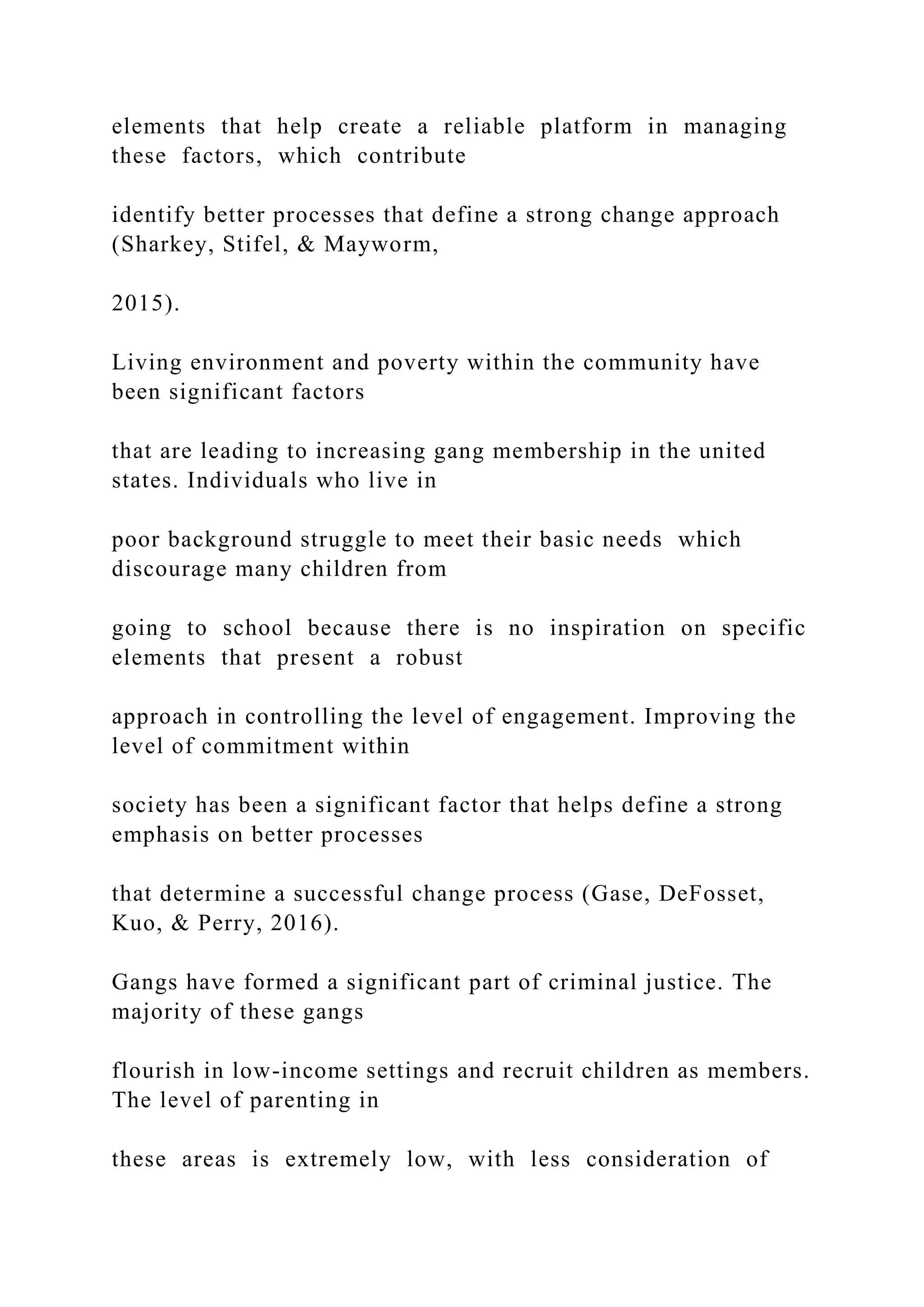
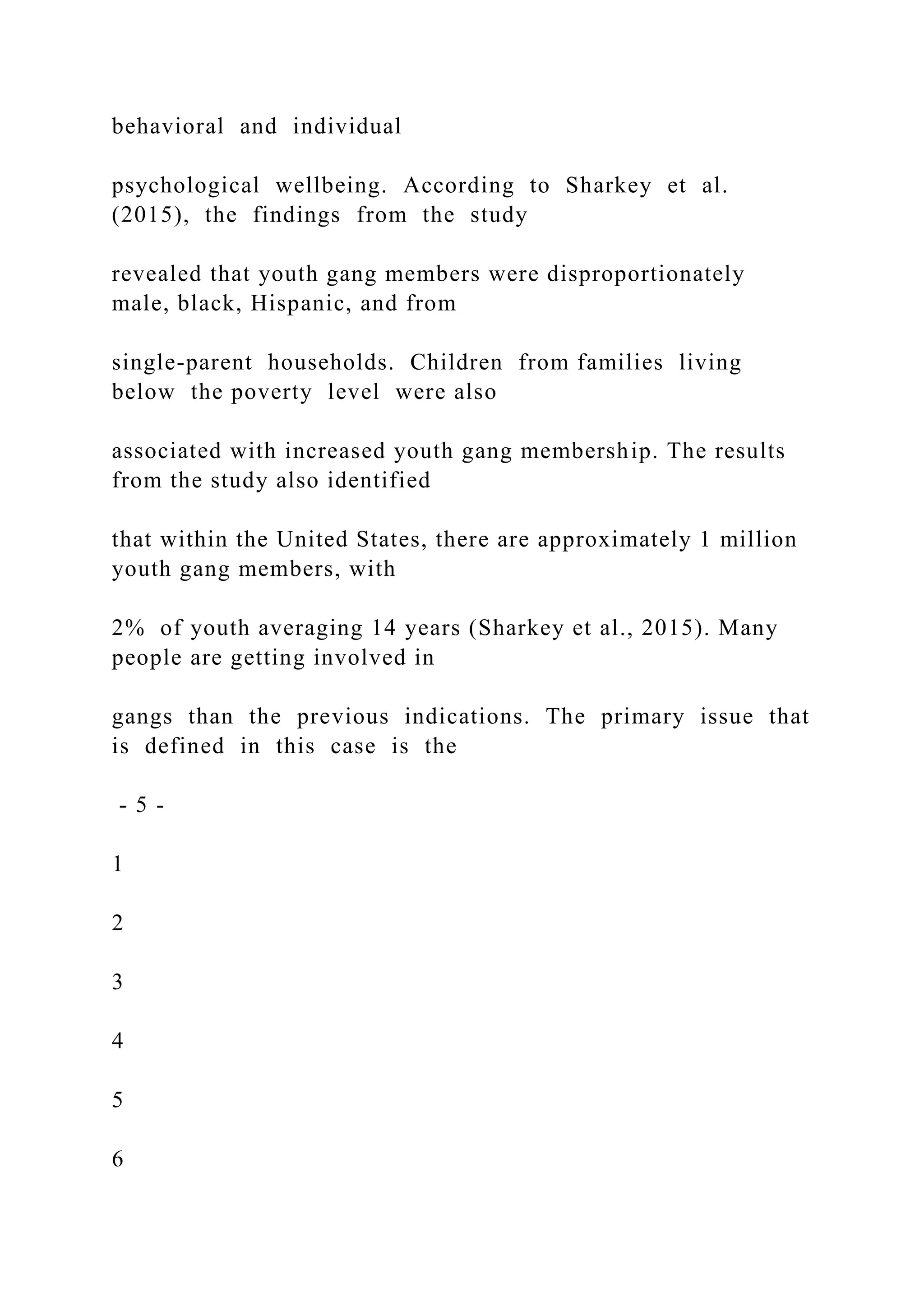
![1. sought to develop an
emphasis on drug use and
violent crimes among
adolescents.
I do not think this sentence
conveys your meaning.
[Marion Baird]
2. united states.
Proper nouns should be
capitalized. [Marion Baird]
3. poor background
Subject-verb agreement:
The subject (noun) of the
sentence should always
agree with its verb (action
word) in number and person.
Example: "The students are
(not 'sis's) excited about](https://image.slidesharecdn.com/runningheadjuveniledelinquencyandtheoryapplication-221025203809-2bd087d0/75/Running-head-JUVENILE-DELINQUENCY-AND-THEORY-APPLICATION-docx-53-2048.jpg)
![returning to school."
[Marion Baird]
4. criminal justice.
Criminal justice or crime?
[Marion Baird]
5. members.
Where is the research
support? [Marion Baird]
6. indications.
source of information?
[Marion Baird]
JUVENILE DELINQUENCY AND THEORY APPLICATION
6
limited emphasis on controlling gang development. High
poverty levels and lack of formal
education have even identified as primary factors that are
associated with gang development.
Gang involvement has become an option for these
individuals. Many youths are](https://image.slidesharecdn.com/runningheadjuveniledelinquencyandtheoryapplication-221025203809-2bd087d0/75/Running-head-JUVENILE-DELINQUENCY-AND-THEORY-APPLICATION-docx-54-2048.jpg)
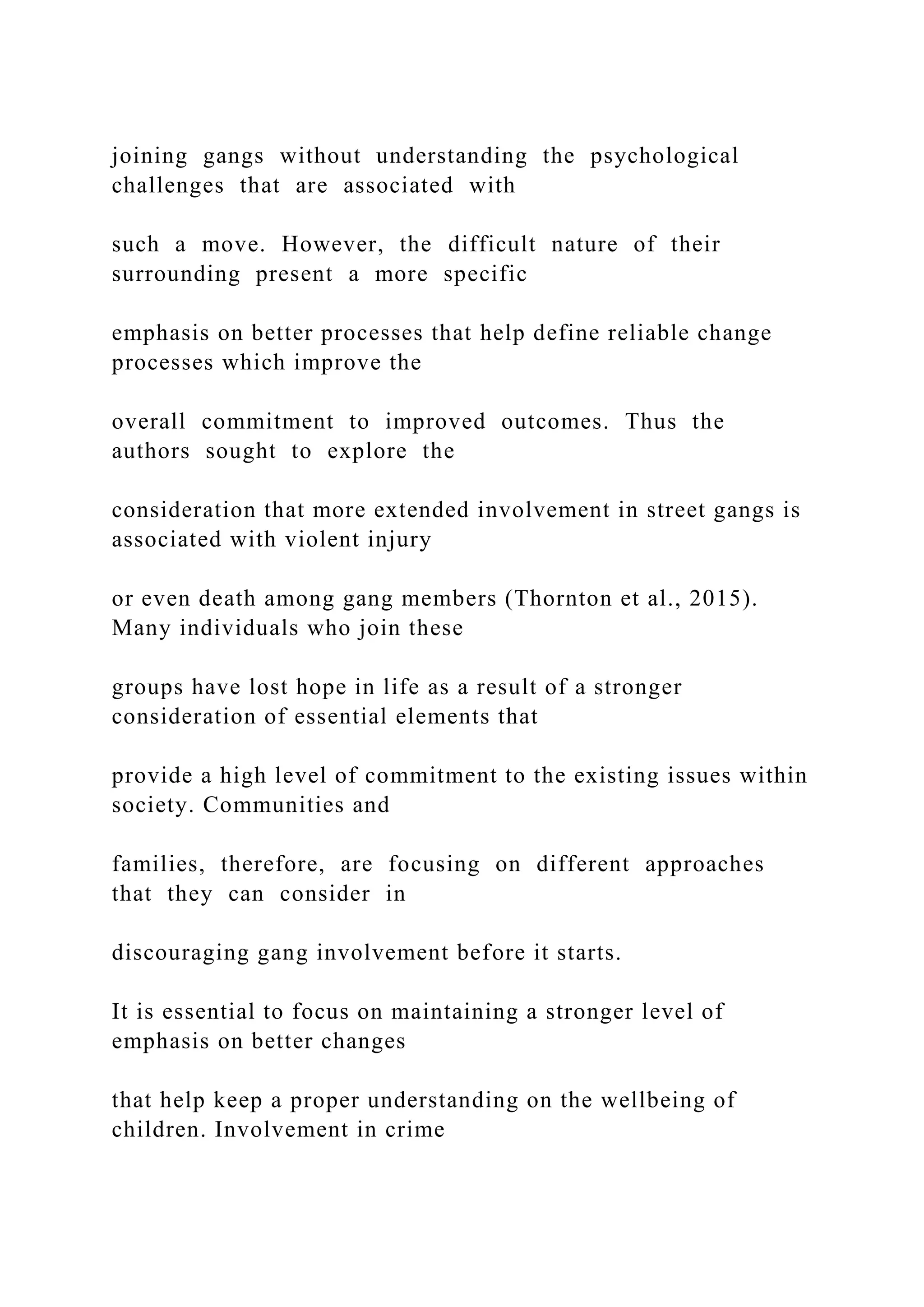
![does not help improve behavioral development, which helps
maintain an improved change
within the environment. The social environment has a crucial
role in improving individual
development, which helps create a reliable system for change as
well as the implementation
of better concepts that help promote an enhanced level of
development. Lack of guidance
among children leaves gaps that are exploited by negative
thoughts influencing an individual
behavior (Whitehead & Lab, 2013). Therefore, it is vital
to help understand different
measures that can be integrated within society and understand
essential measures that can be
implemented to help attain the needed outcomes.
Theories
- 6 -
1
1. Theories
(Review APA format
regarding headings.)
[Marion Baird]](https://image.slidesharecdn.com/runningheadjuveniledelinquencyandtheoryapplication-221025203809-2bd087d0/75/Running-head-JUVENILE-DELINQUENCY-AND-THEORY-APPLICATION-docx-56-2048.jpg)
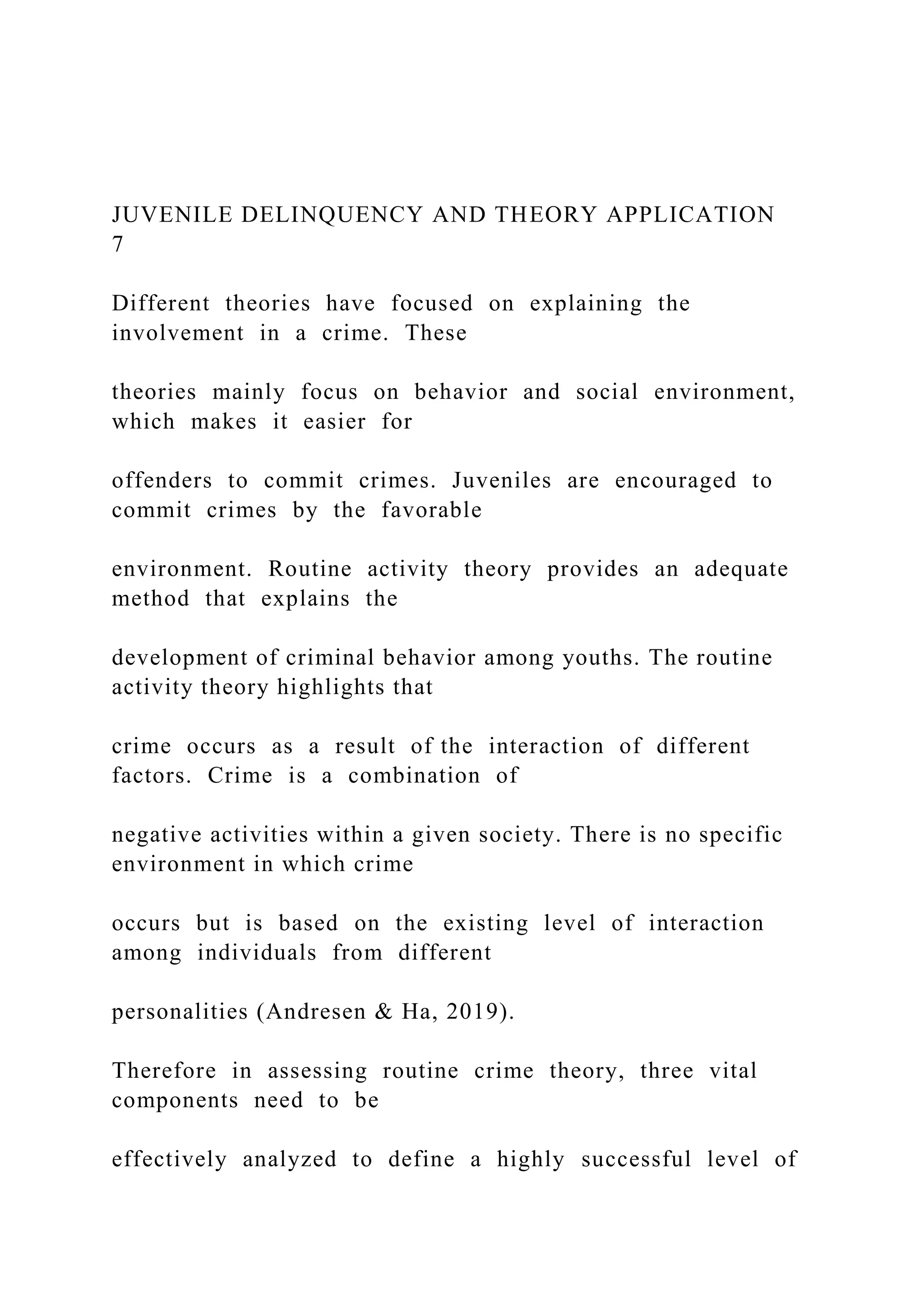
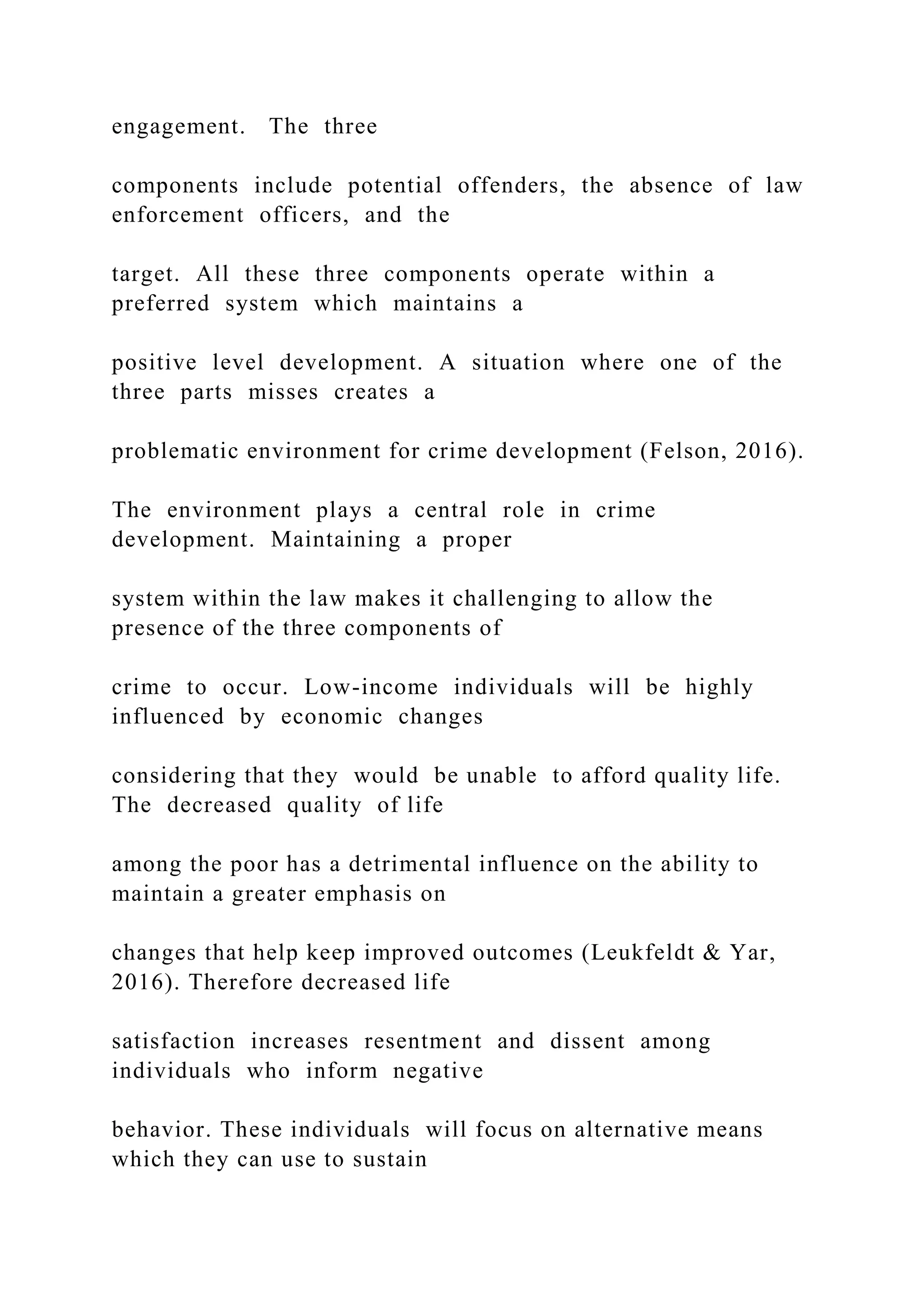
![their lives. One of the easy options is to commit a crime to meet
their needs. Economically
influenced criminal activities have been significant, especially
considering the differences in
- 7 -
1
2
3
4
5
1. environment.
(Please spend some time
thinking about how the
information connects and
work on explaining it in your
writing.) [Marion Baird]
2. no
There is not a ... [Marion
Baird]](https://image.slidesharecdn.com/runningheadjuveniledelinquencyandtheoryapplication-221025203809-2bd087d0/75/Running-head-JUVENILE-DELINQUENCY-AND-THEORY-APPLICATION-docx-59-2048.jpg)
![3. Therefore
comma needed [Marion
Baird]
4. development.
research? [Marion Baird]
5. that
omit [Marion Baird]
JUVENILE DELINQUENCY AND THEORY APPLICATION
8
social status within the community. Low-class individuals are
faced with different problems,
which makes it challenging to avoid crime to meet their needs.
The goal attainment theory also highlights that individual
behavioral development is
based on the level of interaction within the environment.
Thus, child development is a
specific process that helps understand different decisions
within an organizational context.
Implementing a substantial change approach help in
creating a highly successful level of](https://image.slidesharecdn.com/runningheadjuveniledelinquencyandtheoryapplication-221025203809-2bd087d0/75/Running-head-JUVENILE-DELINQUENCY-AND-THEORY-APPLICATION-docx-60-2048.jpg)
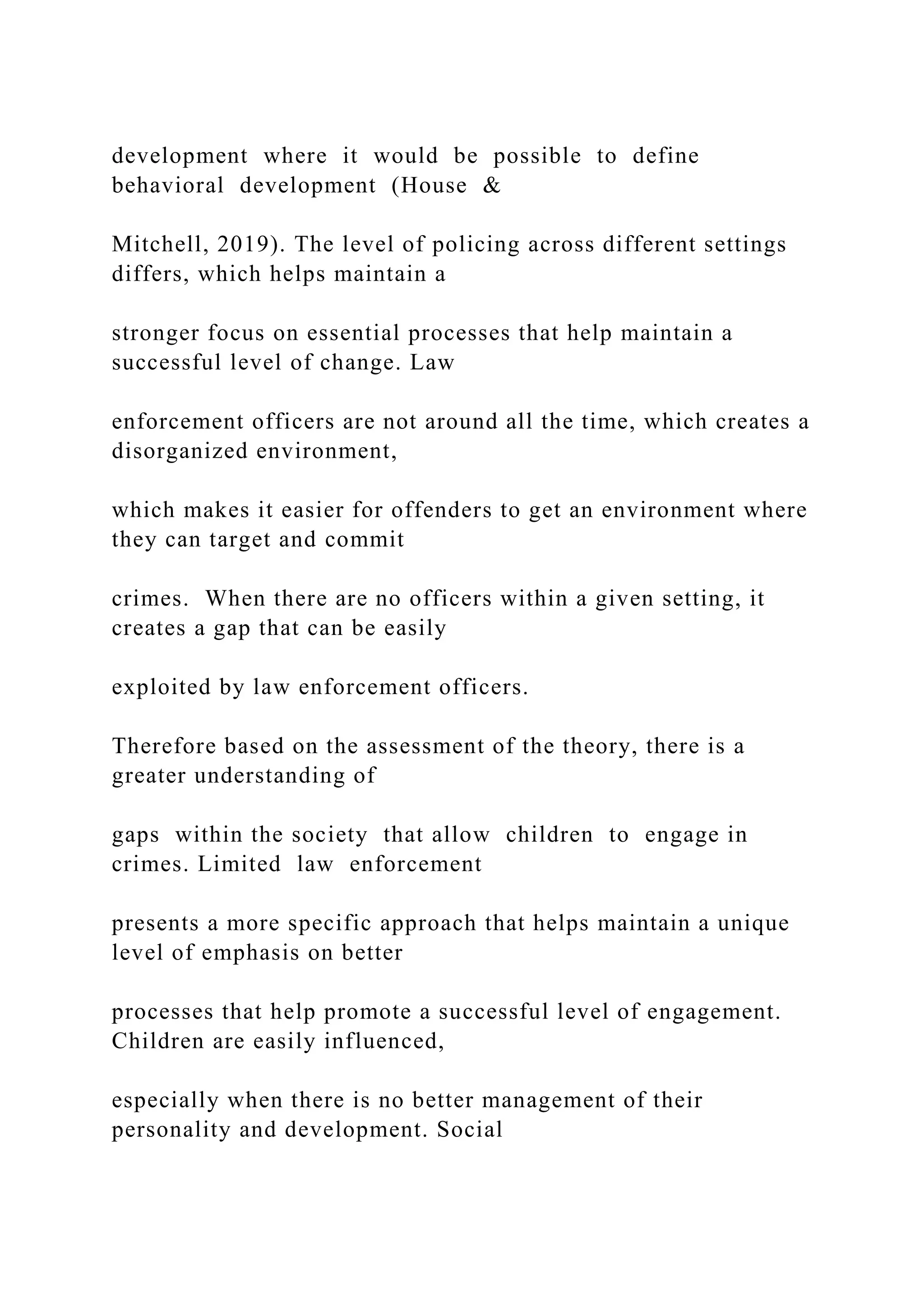

![can make this assumption.)
[Marion Baird]
2. context.
How? [Marion Baird]
3. Therefore
comma needed [Marion
Baird]
4. Eriksen's theory
source? [Marion Baird]
JUVENILE DELINQUENCY AND THEORY APPLICATION
9
understanding, which plays a significant role in transforming
their behavior. It is crucial to
help ensure a greater emphasis on critical processes that help
identify better measures that
shape individual development. Children have different levels of
understanding, which plays a
crucial role in determining their overall growth (Mann, De
Ridder, and Fujita, 2013).](https://image.slidesharecdn.com/runningheadjuveniledelinquencyandtheoryapplication-221025203809-2bd087d0/75/Running-head-JUVENILE-DELINQUENCY-AND-THEORY-APPLICATION-docx-63-2048.jpg)
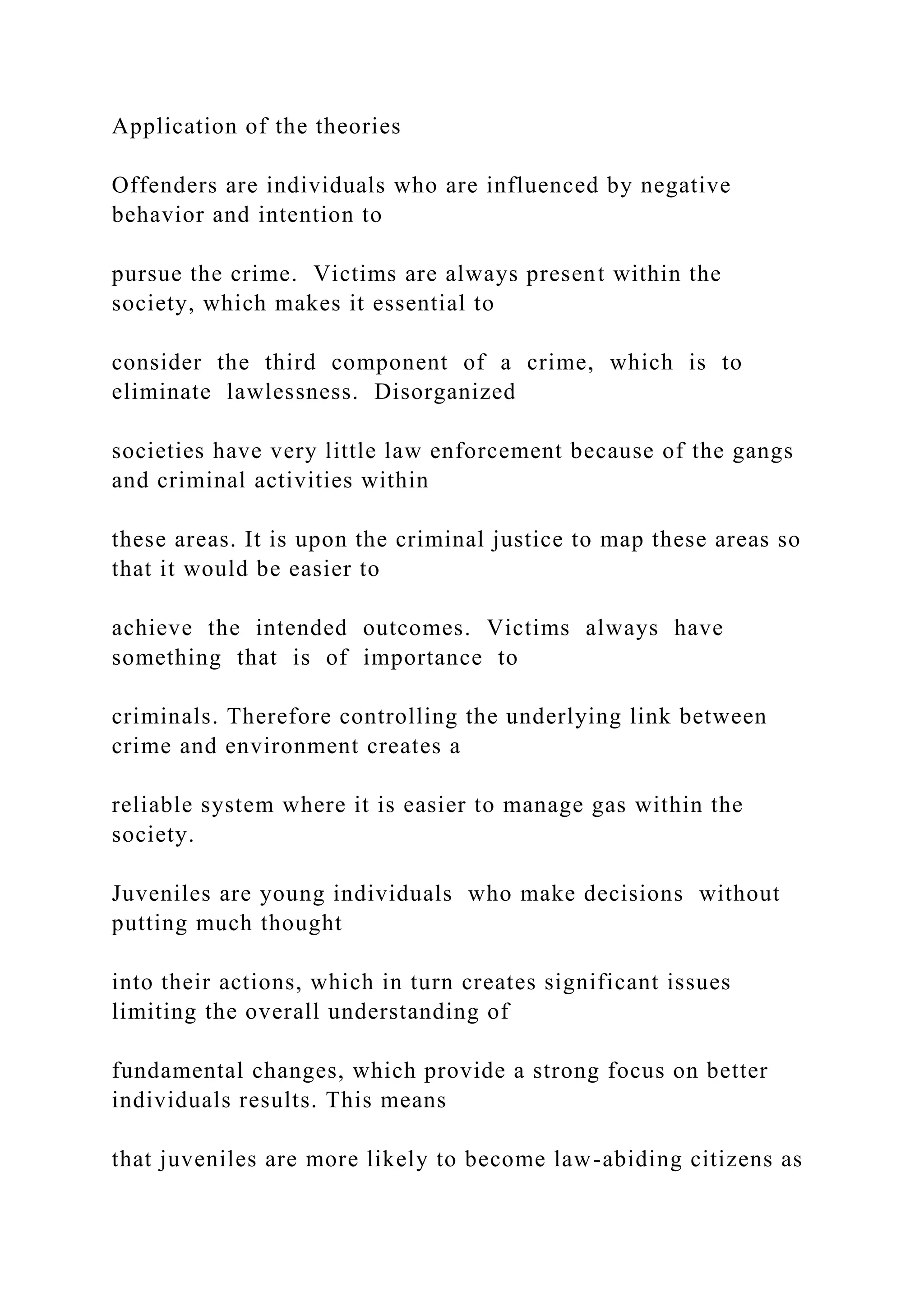
![they mature, and thus, they
are less likely to be given long prison sentences compared to
adults. Juvenile offenders are
considered offenders who can quickly transform. Therefore,
they are not treated as hardcore
criminals, but there is a significant focus on rehabilitation
rather than punitive aspects in
managing their needs. However, there are substantial risks for
juvenile offenders if they are
tried as adults (Whitehead & Lab, 2013).
Controlling crime among juveniles requires a stranger approach,
which helps maintain
a stronger system, which is essential in embracing strong
change development. Maintaining a
- 9 -
1
1. theories
(Review APA format
regarding headings.)
[Marion Baird]](https://image.slidesharecdn.com/runningheadjuveniledelinquencyandtheoryapplication-221025203809-2bd087d0/75/Running-head-JUVENILE-DELINQUENCY-AND-THEORY-APPLICATION-docx-65-2048.jpg)
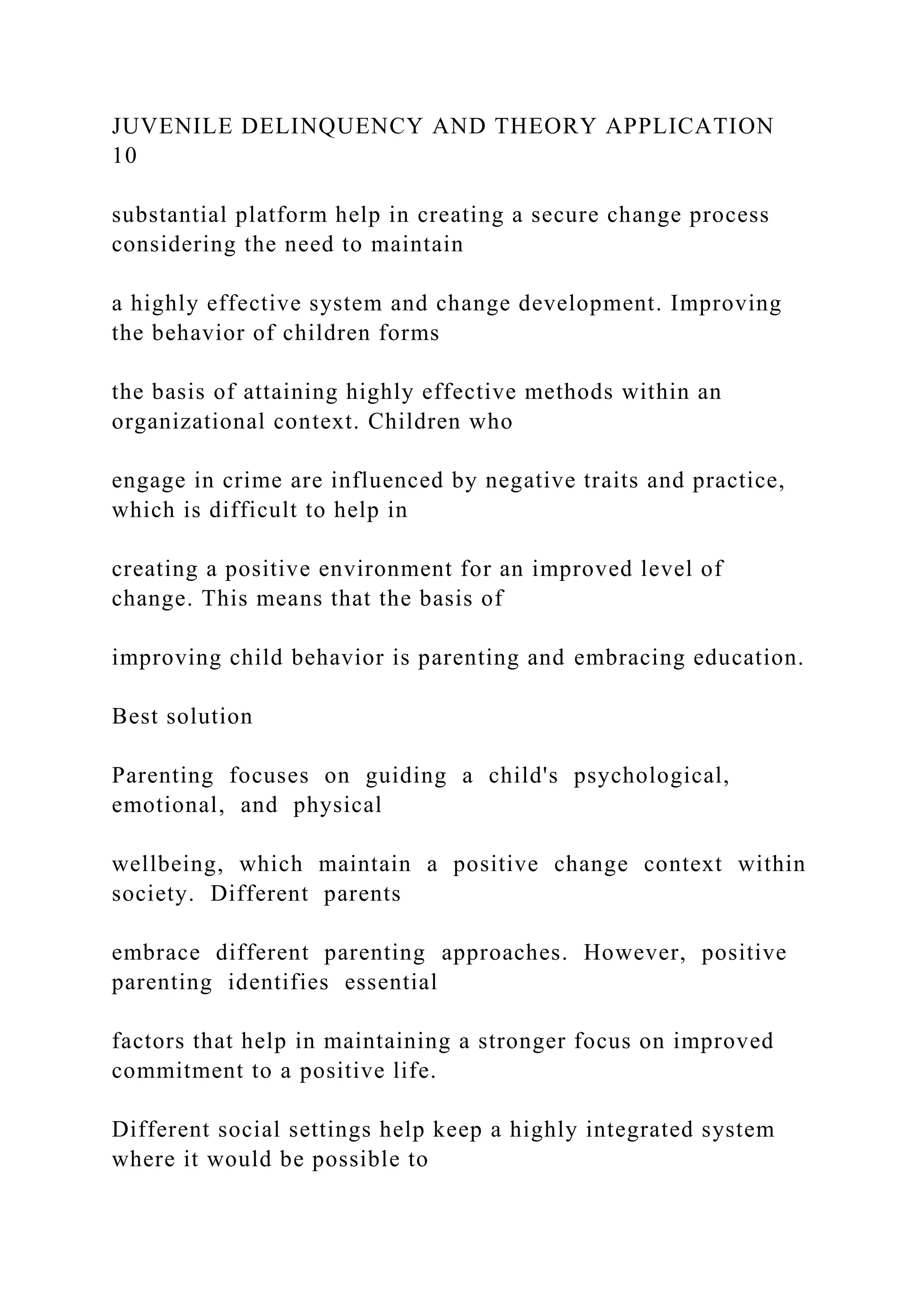

![- 10 -
1
1. wellbeing.
Where is the research?
[Marion Baird]
JUVENILE DELINQUENCY AND THEORY APPLICATION
11
there are diverse concepts leaned based on the parenting style
that is adopted (Sharkey, Stifel,
and Mayworm, 2015). Having control over what a child
learns plays an integral role in
creating a harmonious environment where it is possible to
maintain a more significant
commitment to underlying outcomes.
Ensuring that children attend school and gather skills that can
boost their development
within society is also a significant way in controlling juvenile
delinquency. Quality education
is developed founded on the underlying systems and
philosophies which focus on guiding](https://image.slidesharecdn.com/runningheadjuveniledelinquencyandtheoryapplication-221025203809-2bd087d0/75/Running-head-JUVENILE-DELINQUENCY-AND-THEORY-APPLICATION-docx-68-2048.jpg)
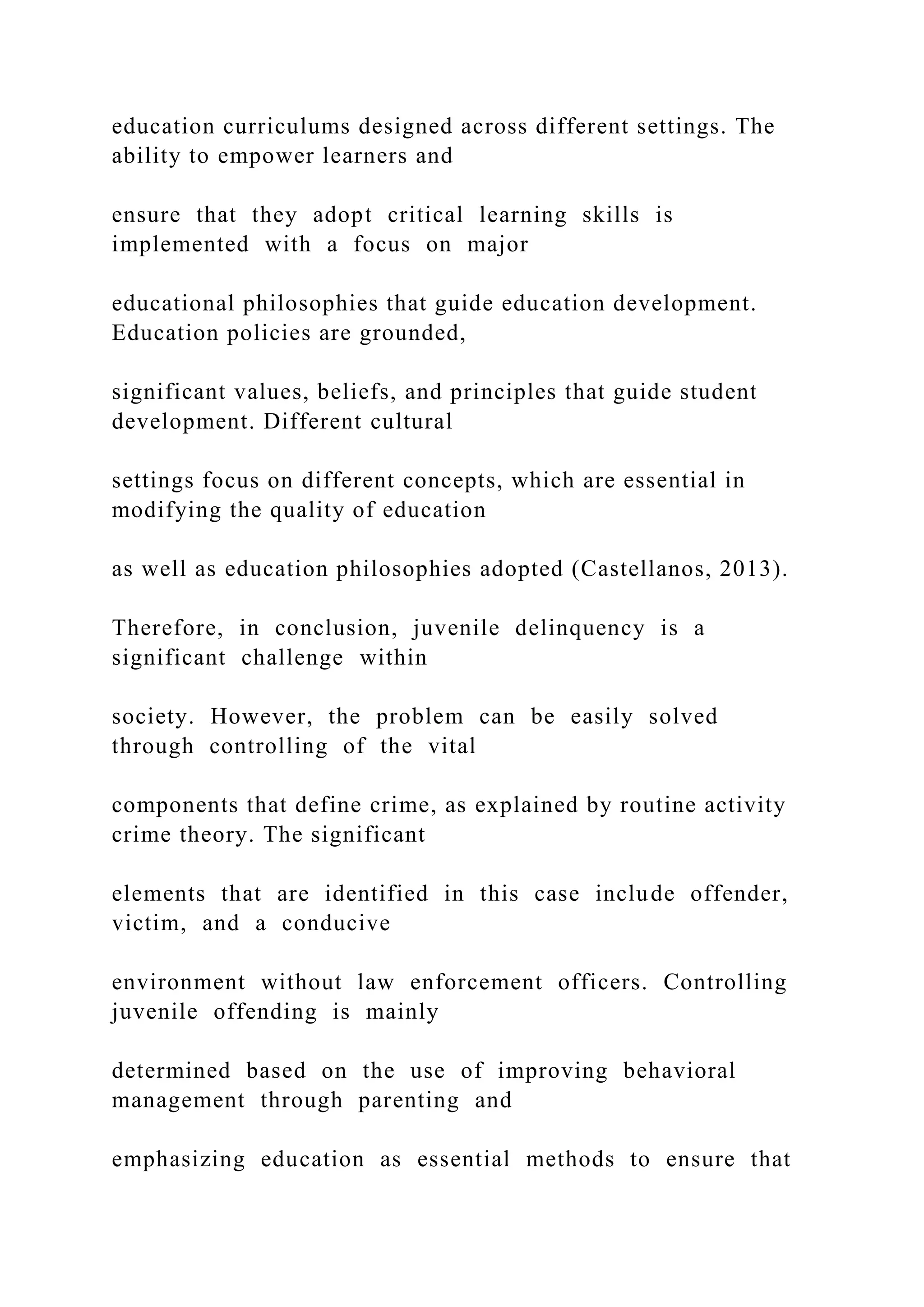
![children can develop into law-
abiding citizens who are the future. Promoting the future of
law-abiding citizens starts with
understanding better processes that help identify critical
processes that define positive change
within the community.
- 11 -
[no notes on this page]
JUVENILE DELINQUENCY AND THEORY APPLICATION
12
Reference
Andresen, M. A., & Ha, O. K. (2019). Routine activity theory.
In The Routledge Companion
to Criminological Theory and Concepts.
https://doi.org/10.4324/9781315744902-121
Castellanos, I. E. (2013). Parental and peer influence on
juvenile delinquency. ProQuest
Dissertations and Theses.
Felson, M. (2016). The routine activity approach. In
Environmental Criminology and Crime
Analysis: Second Edition.](https://image.slidesharecdn.com/runningheadjuveniledelinquencyandtheoryapplication-221025203809-2bd087d0/75/Running-head-JUVENILE-DELINQUENCY-AND-THEORY-APPLICATION-docx-70-2048.jpg)

![References page must
follow APA guidelines.
[Marion Baird]
JUVENILE DELINQUENCY AND THEORY APPLICATION
13
Mann, T., De Ridder, D., & Fujita, K. (2013). Self-regulation of
health behavior: Social
psychological approaches to goal setting and goal striving.
Health Psychology.
https://doi.org/10.1037/a0028533
Matza, D., & Sykes, G. M. (2017). Juvenile delinquency and
subterranean values. In
Delinquency and Drift Revisited: The Criminology of David
Matza and Beyond.
https://doi.org/10.4324/9781315157962
Sharkey, J., Stifel, S., & Mayworm, A. (2015). How to help me
get out of a gang: Youth
Recommendations to Family, School, Community, and Law
Enforcement System.
Journal of Juvenile Justice.
Thornton, L. C., Frick, P. J., Shulman, E. P., Ray, J. V.,](https://image.slidesharecdn.com/runningheadjuveniledelinquencyandtheoryapplication-221025203809-2bd087d0/75/Running-head-JUVENILE-DELINQUENCY-AND-THEORY-APPLICATION-docx-72-2048.jpg)
![Steinberg, L., & Cauffman, E. (2015).
Callous-Unemotional Traits and Adolescents’ Role in Group
Crime. Law and Human
Behavior. https://doi.org/10.1037/lhb0000124
Unayah, N., & Sabarisman, M. (2015). the Phenomenon of
Juvenile Delinquency and
Criminality. Sosio Informa.
https://doi.org/http://dx.doi.org/10.22146/jpsi.6959
Whitehead, J. T., & Lab, S. P. (2013). Chapter 14 – Future
Directions in Juvenile Justice. In
Juvenile Justice. https://doi.org/10.1016/B978-1-4557-7892-
8.00014-7
- 13 -
[no notes on this page]](https://image.slidesharecdn.com/runningheadjuveniledelinquencyandtheoryapplication-221025203809-2bd087d0/75/Running-head-JUVENILE-DELINQUENCY-AND-THEORY-APPLICATION-docx-73-2048.jpg)